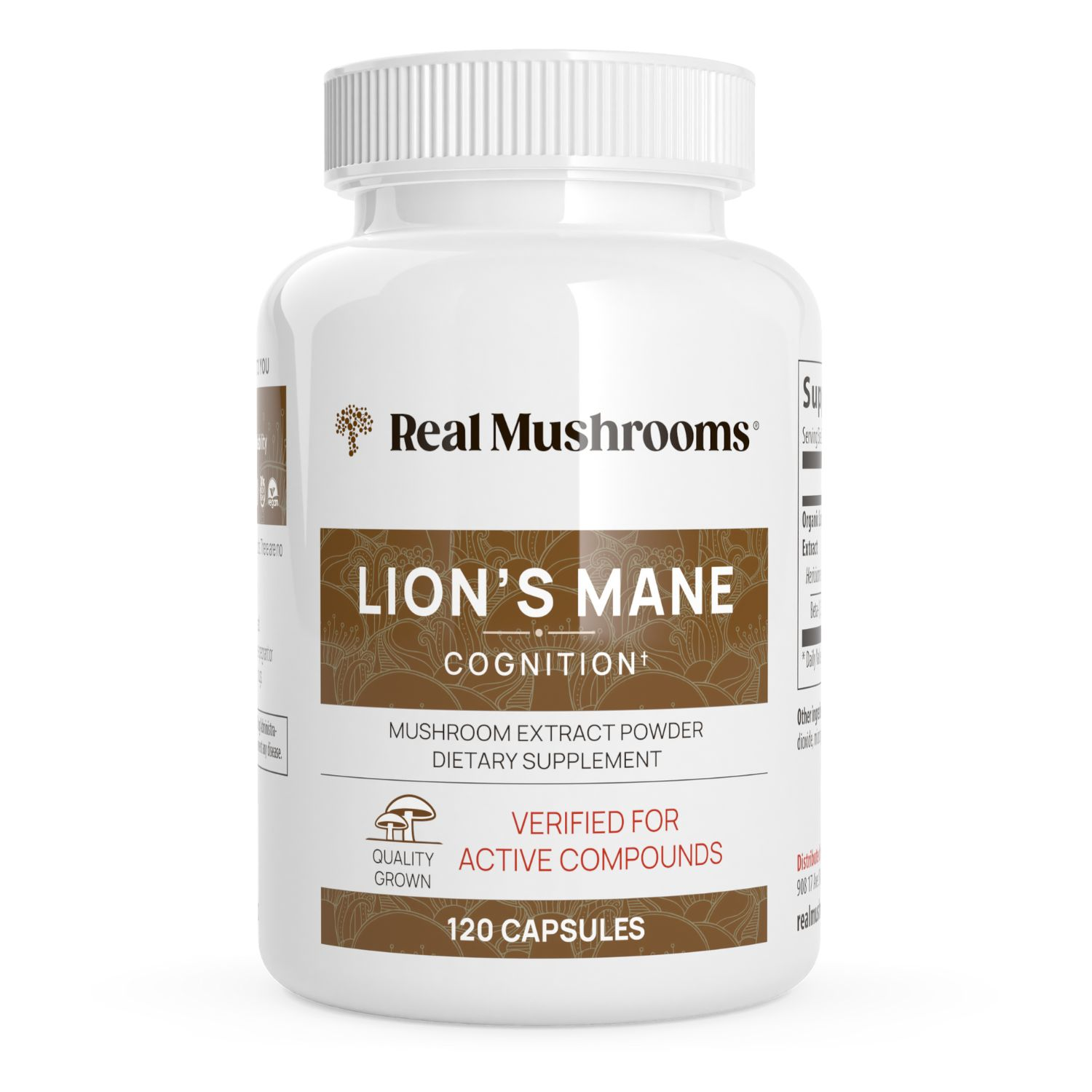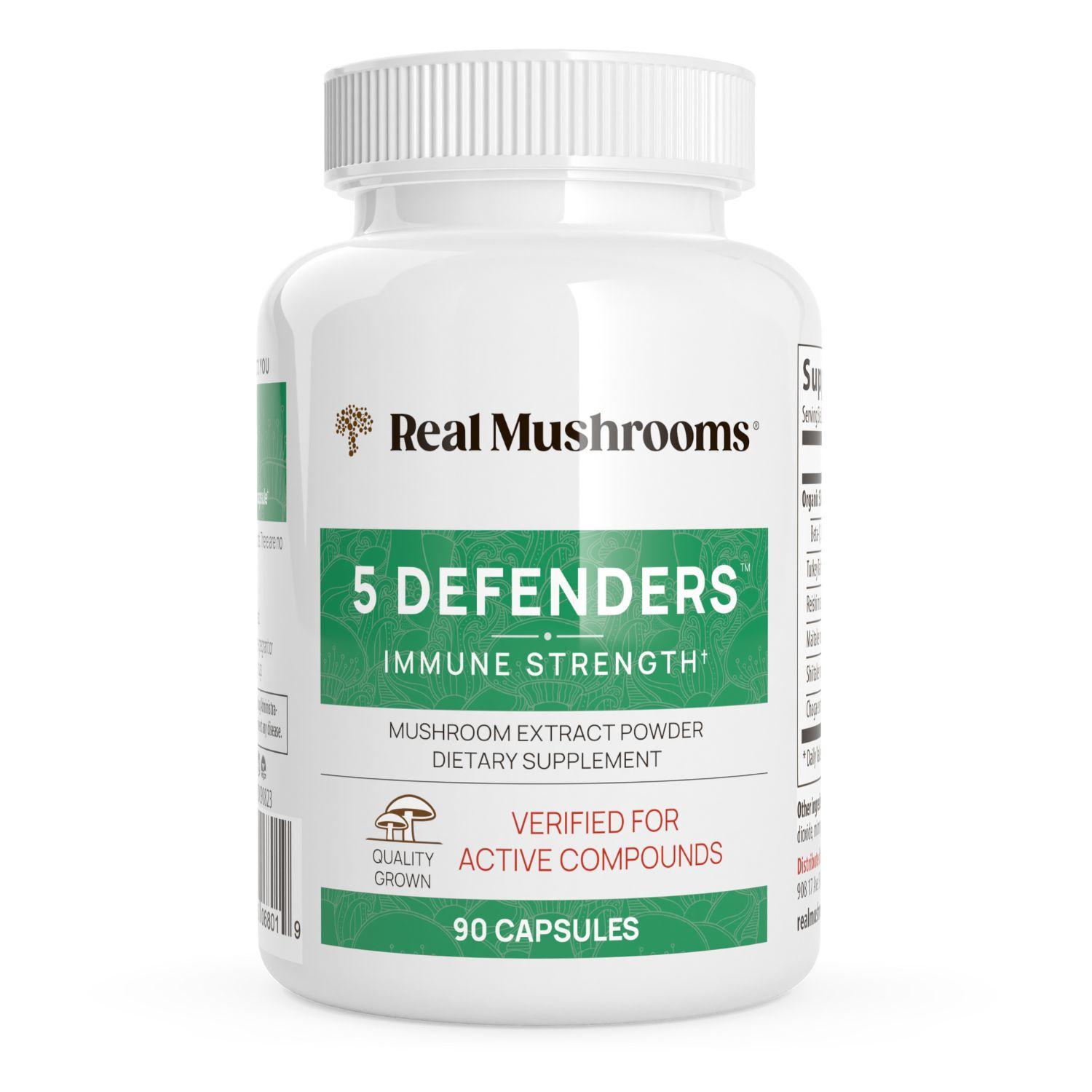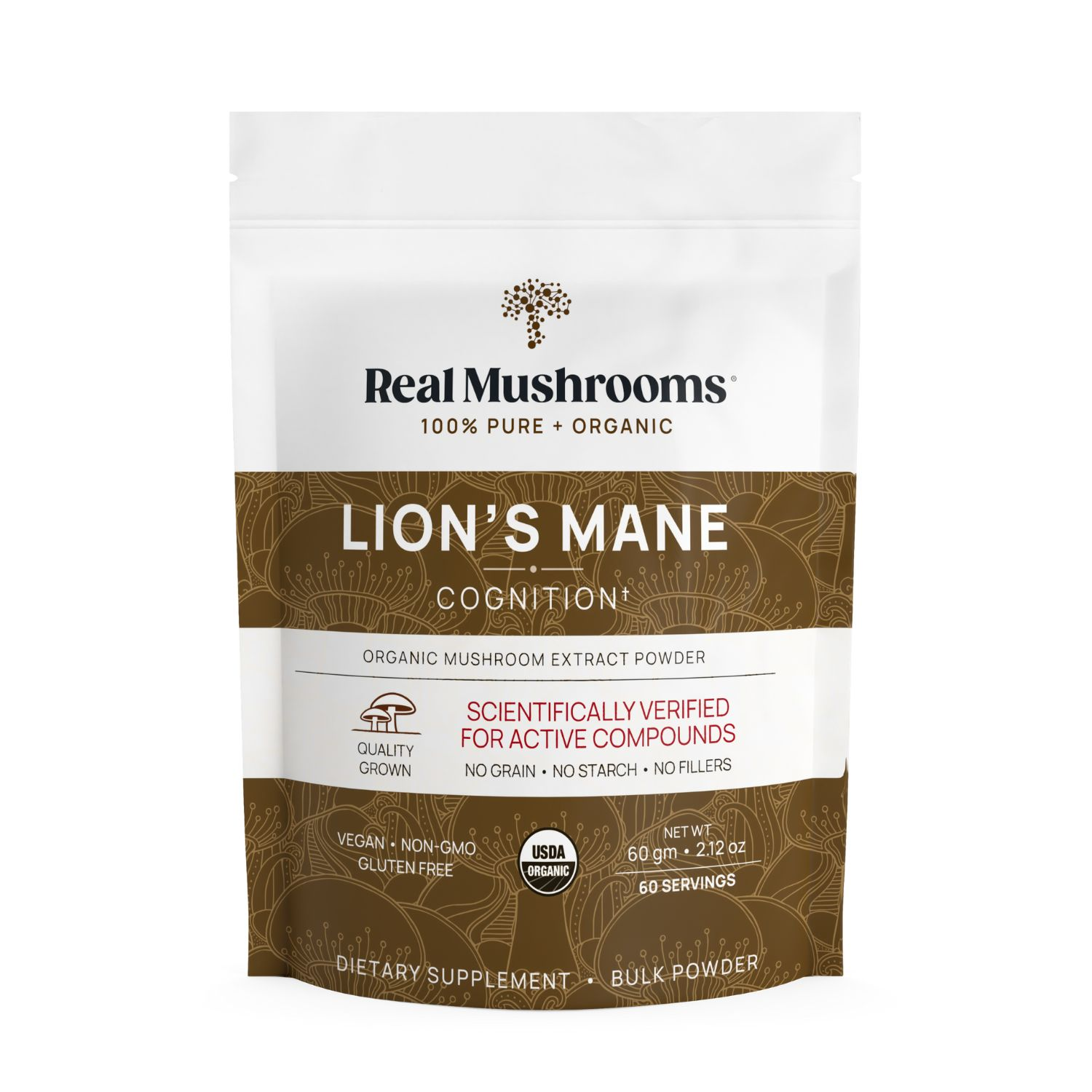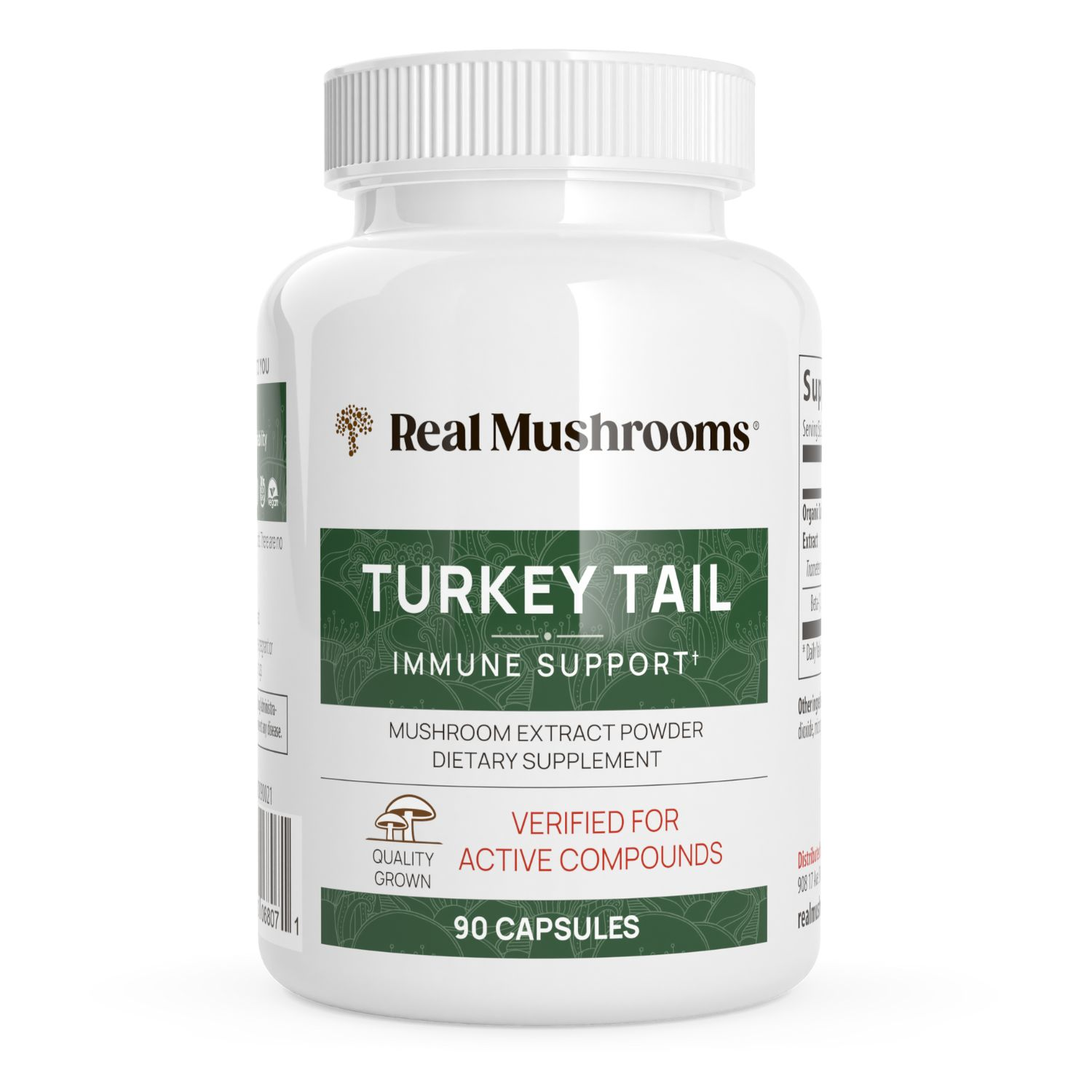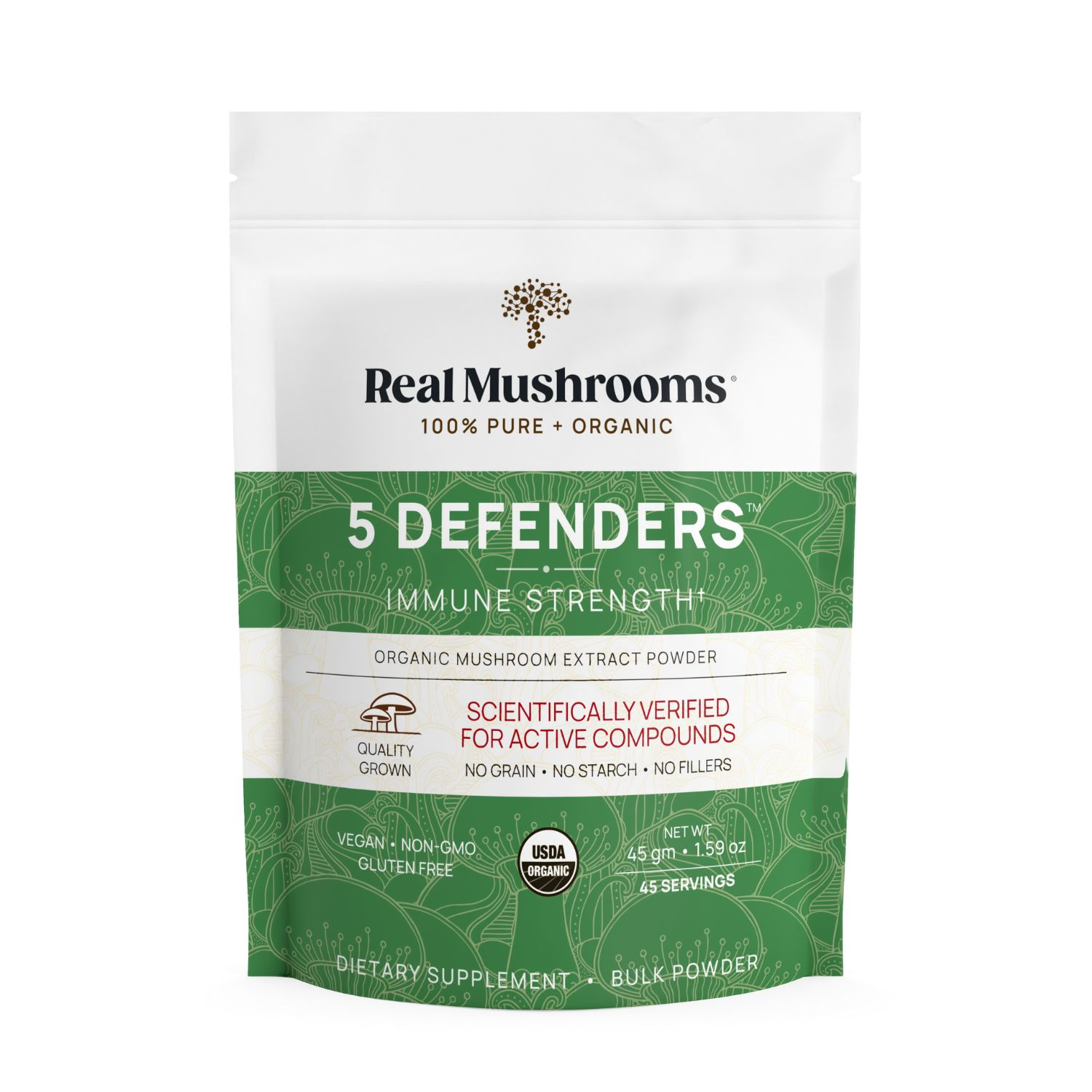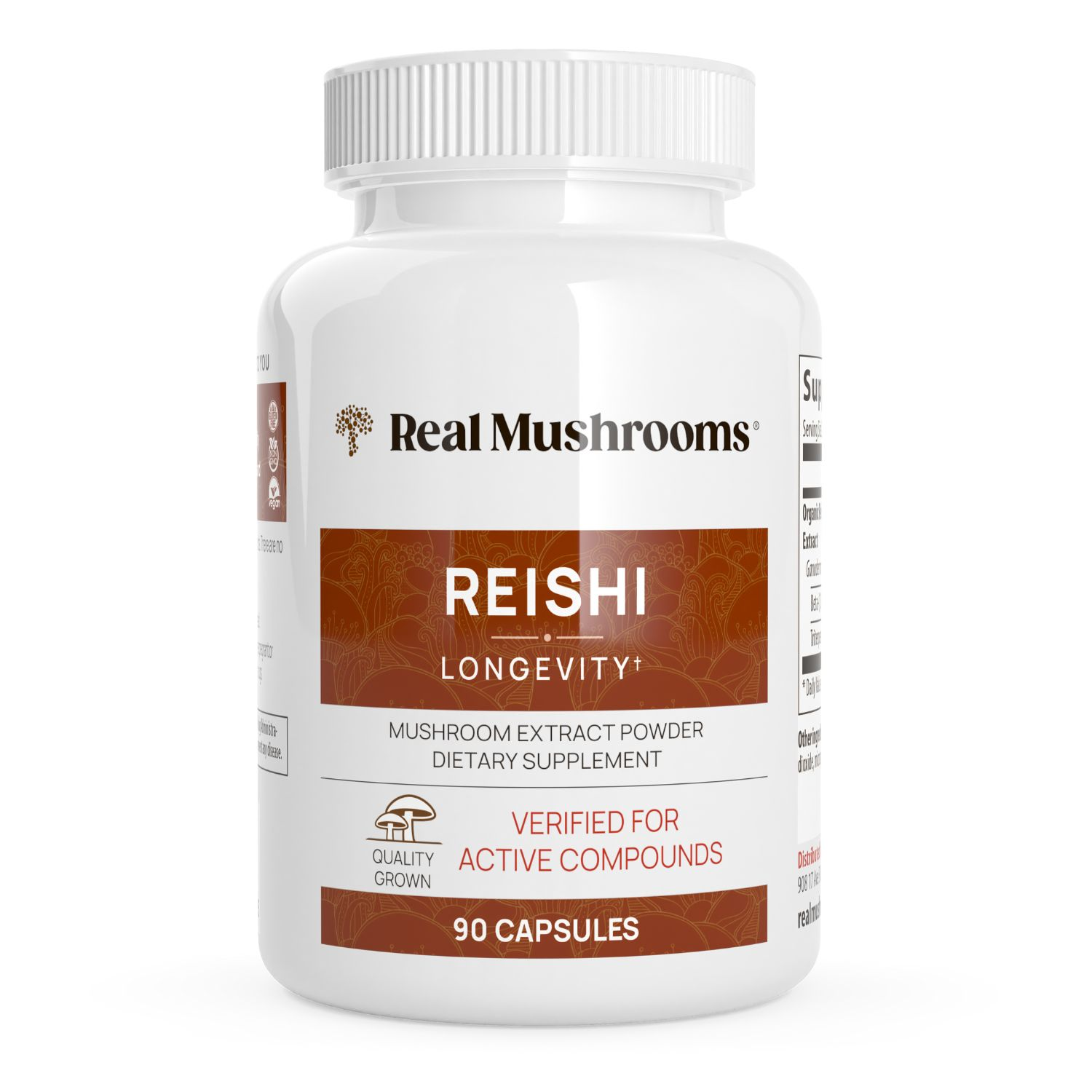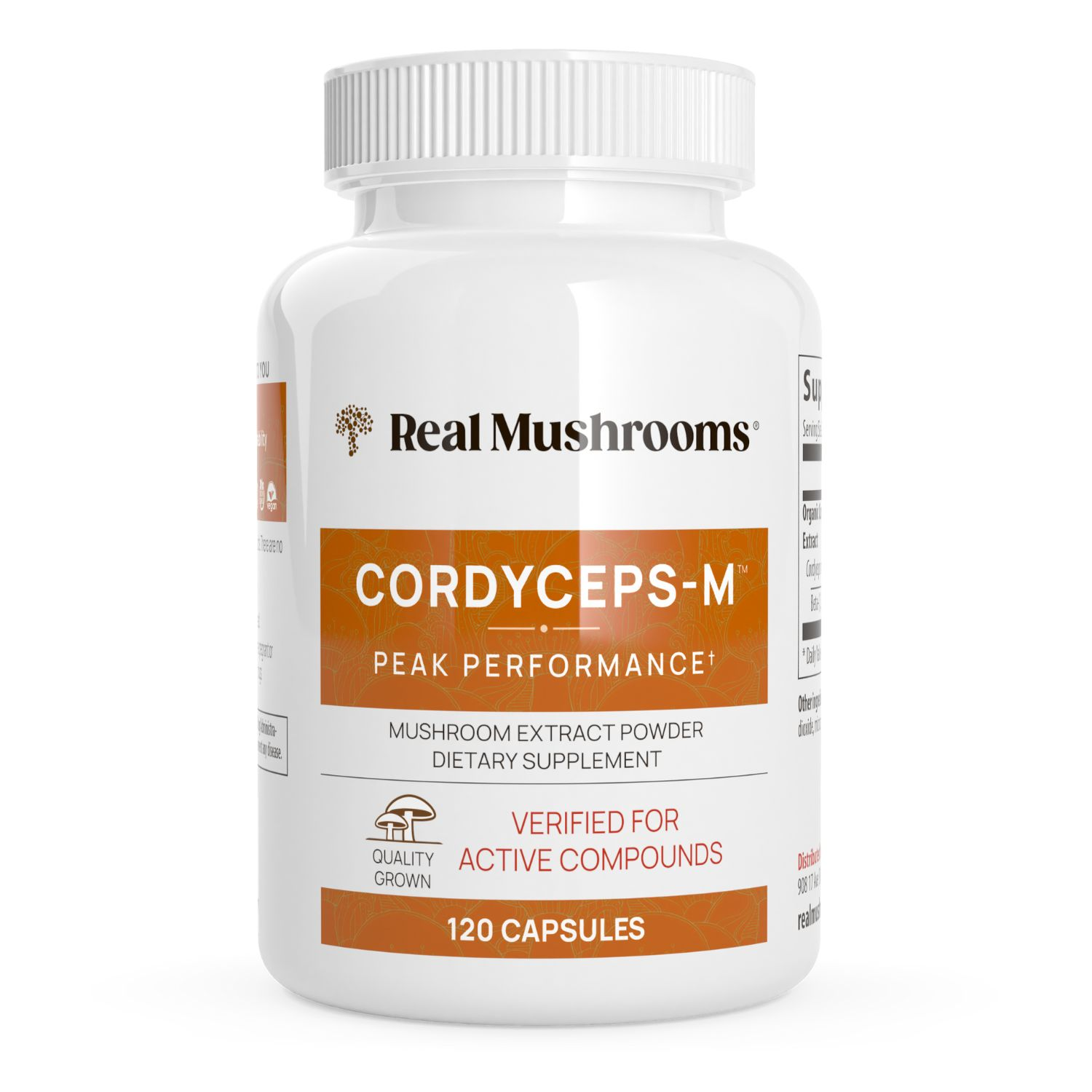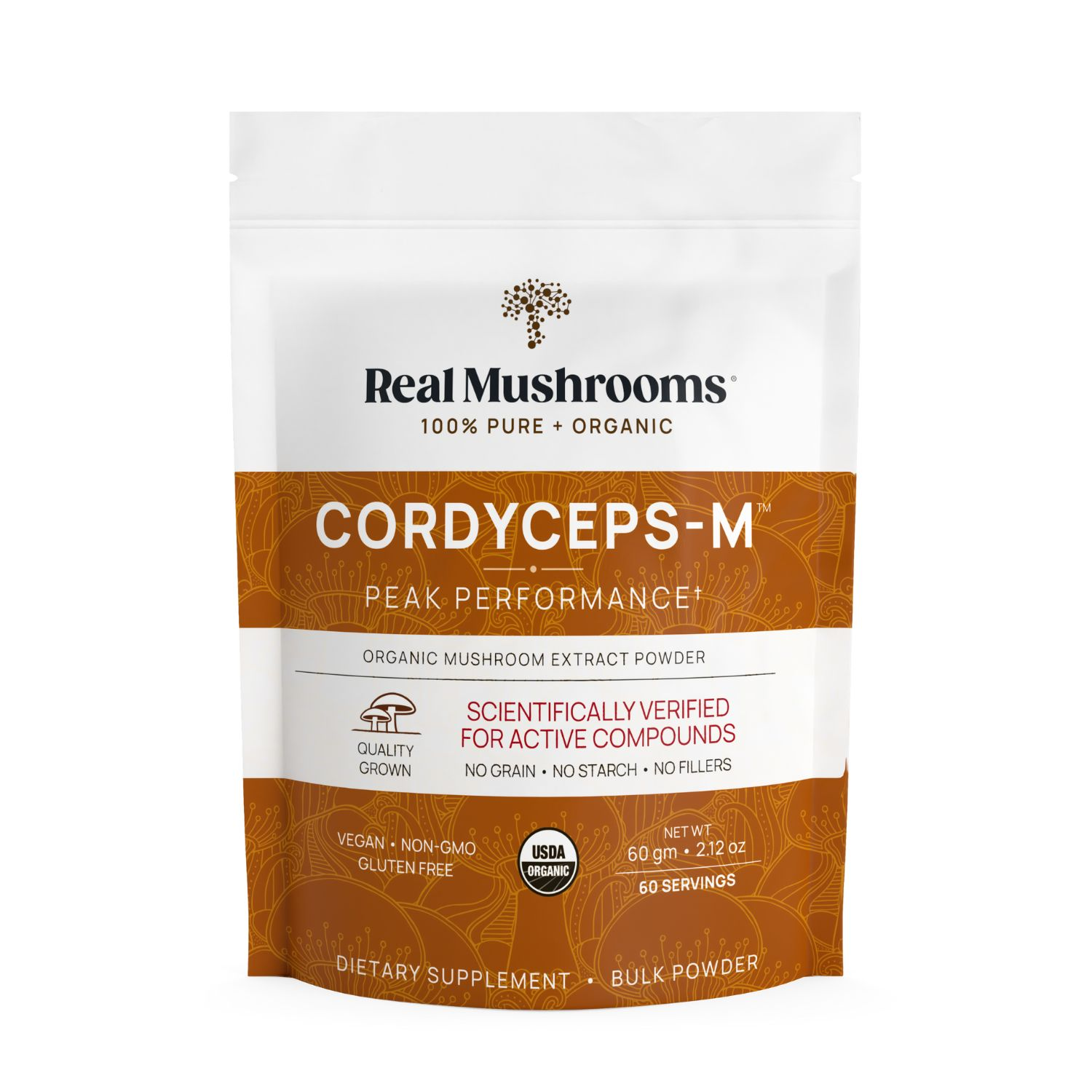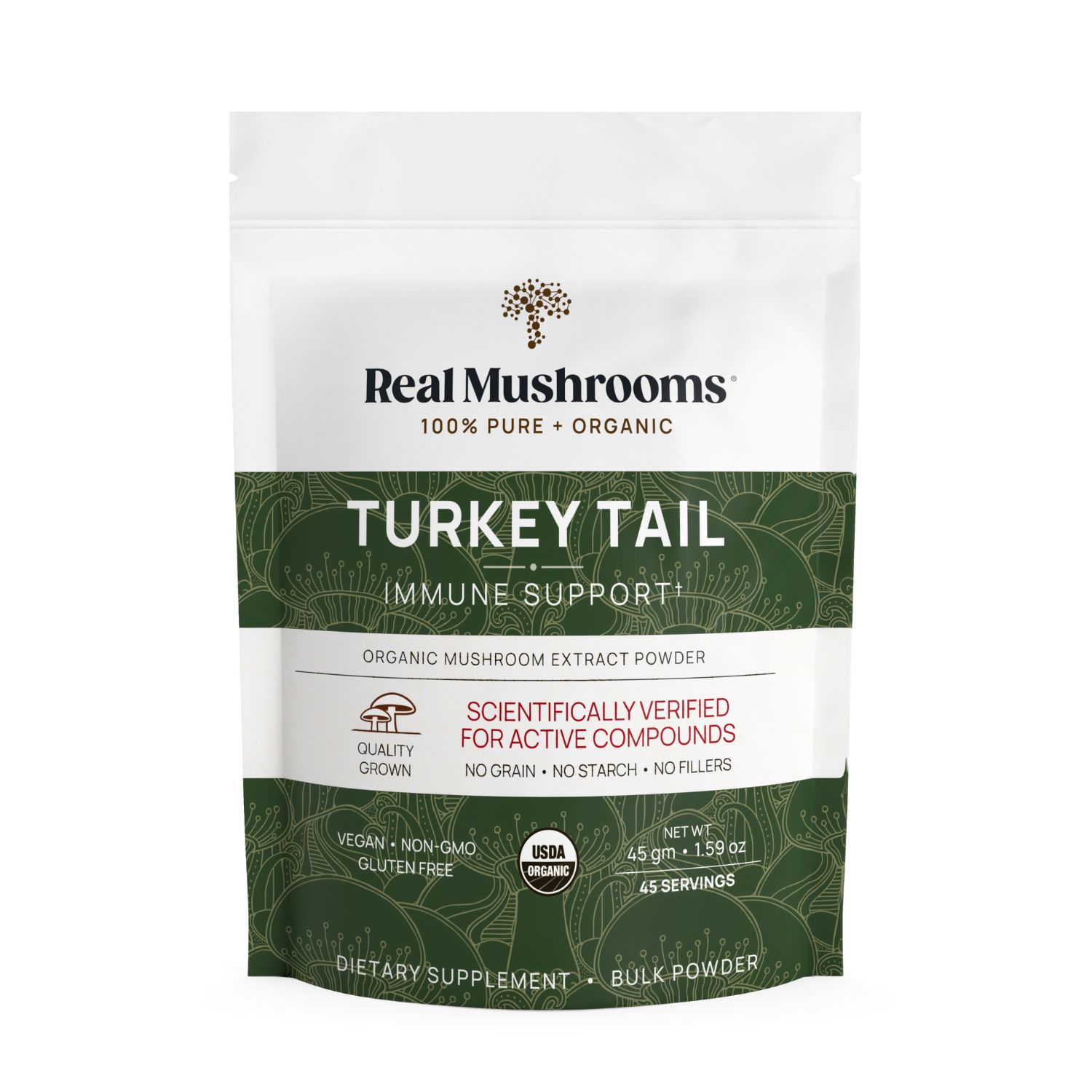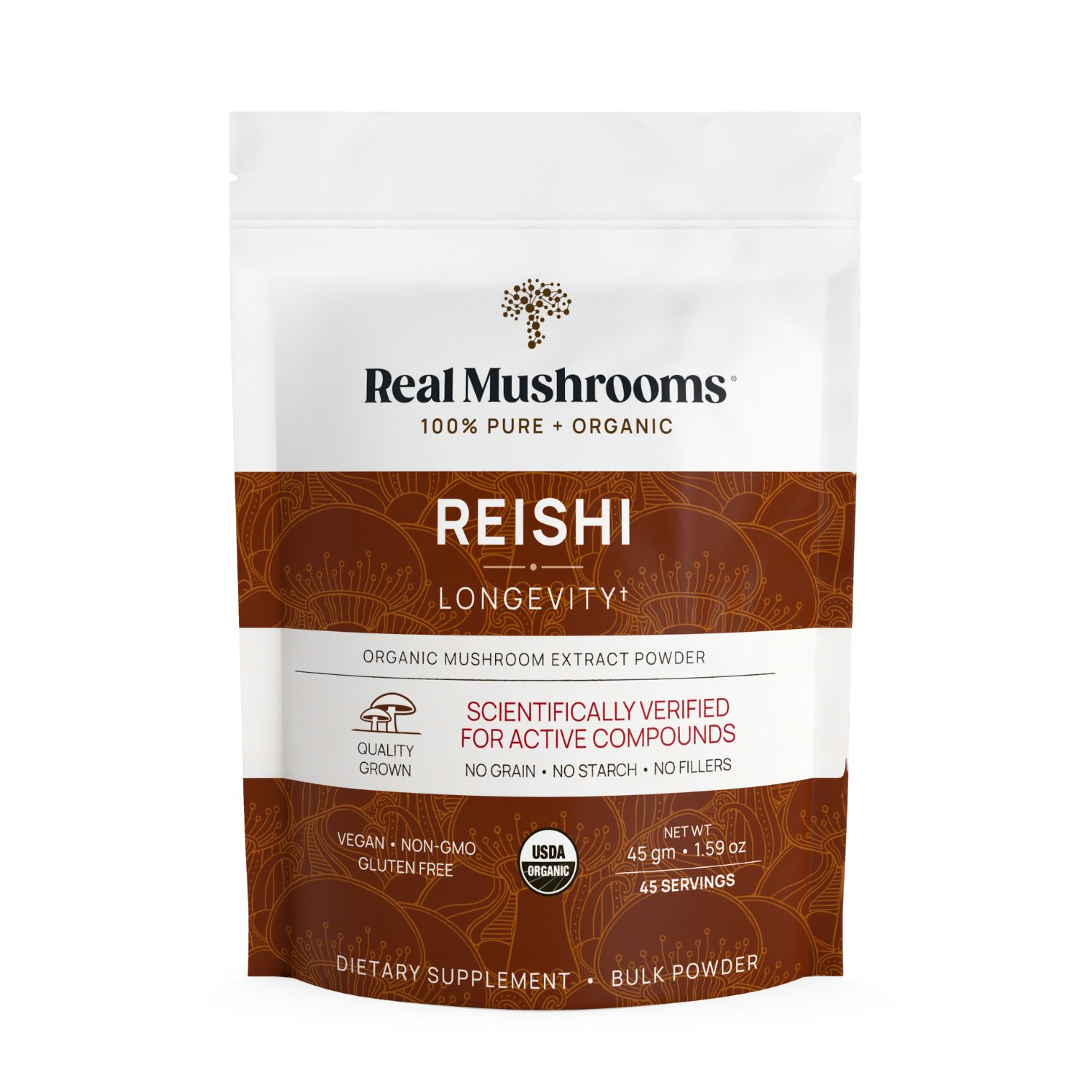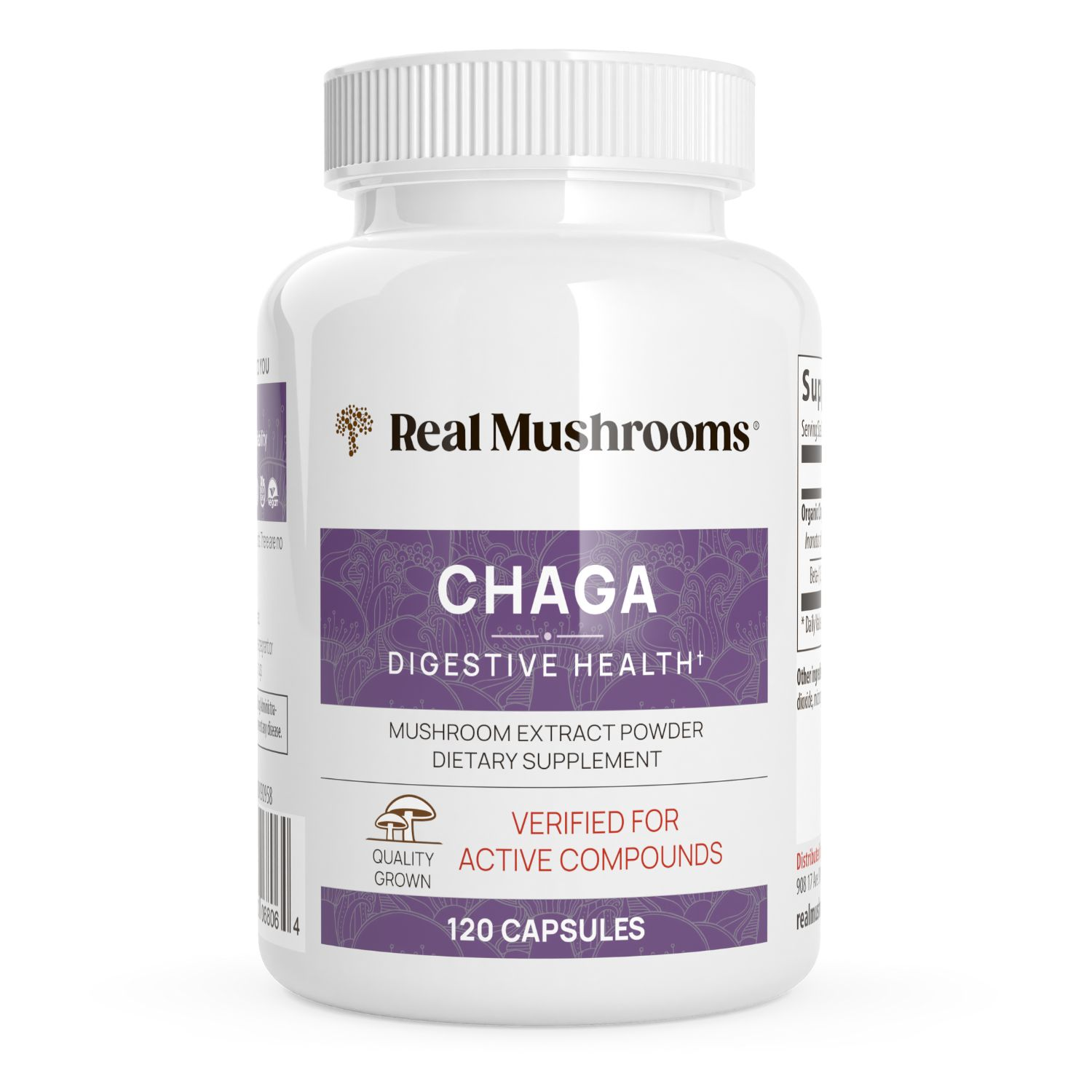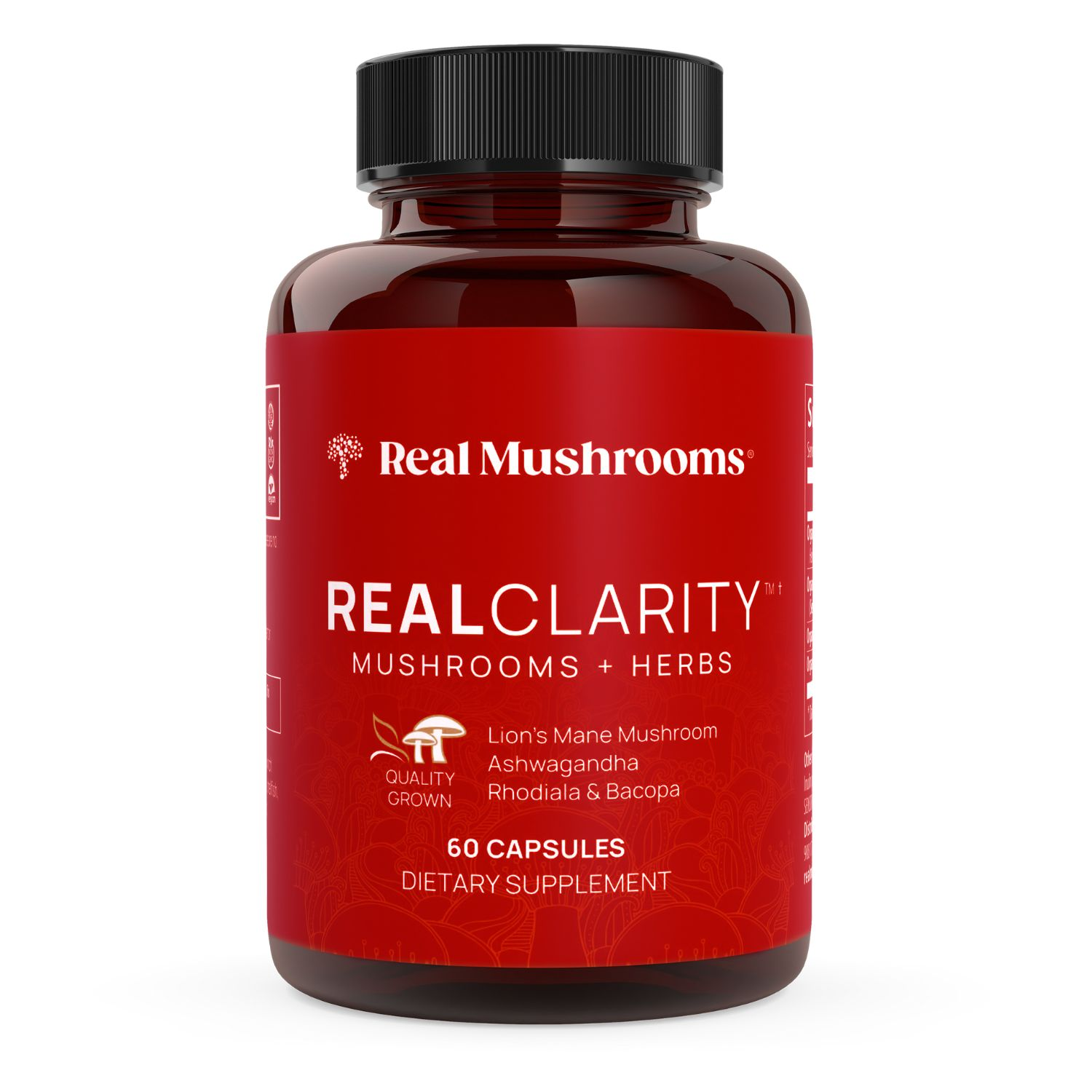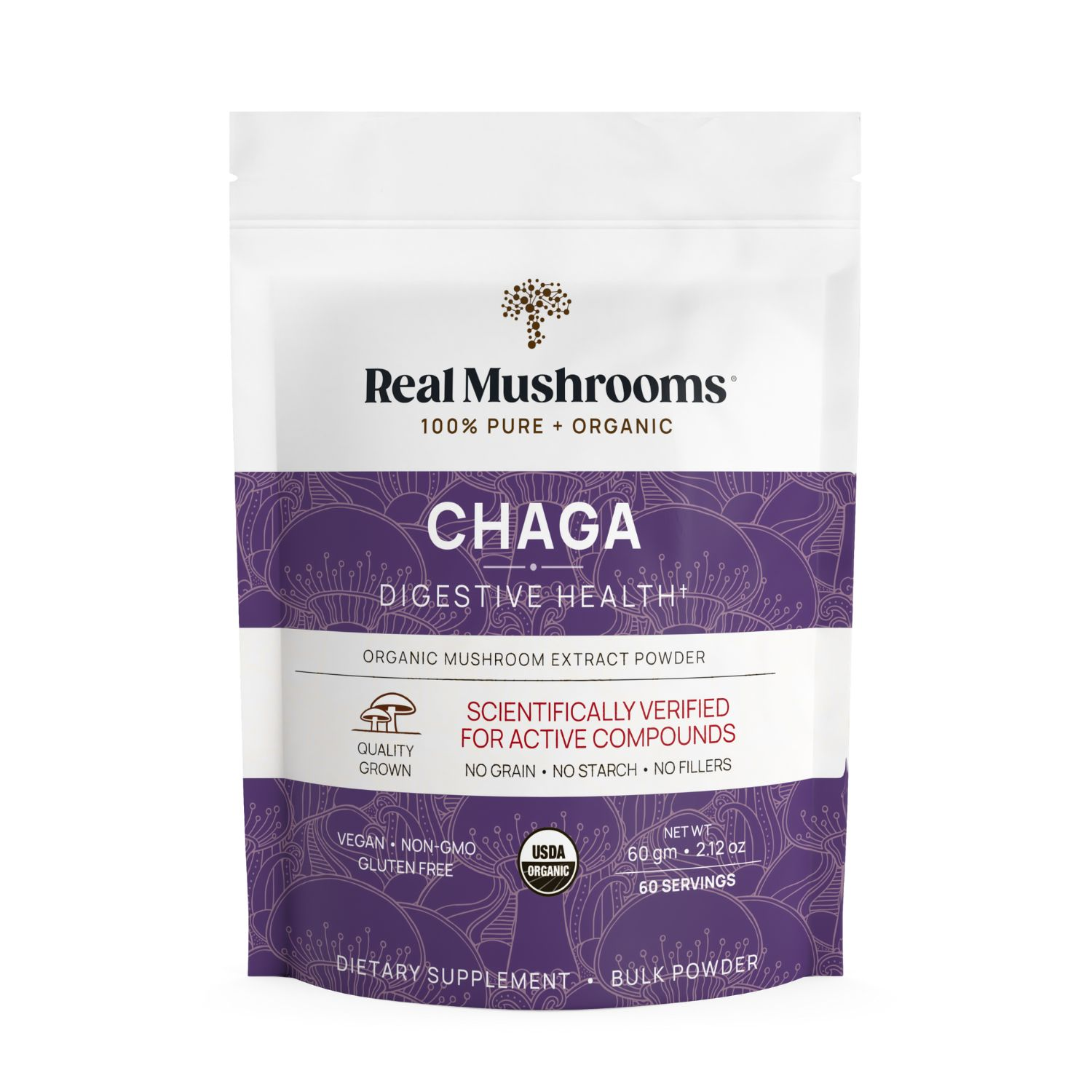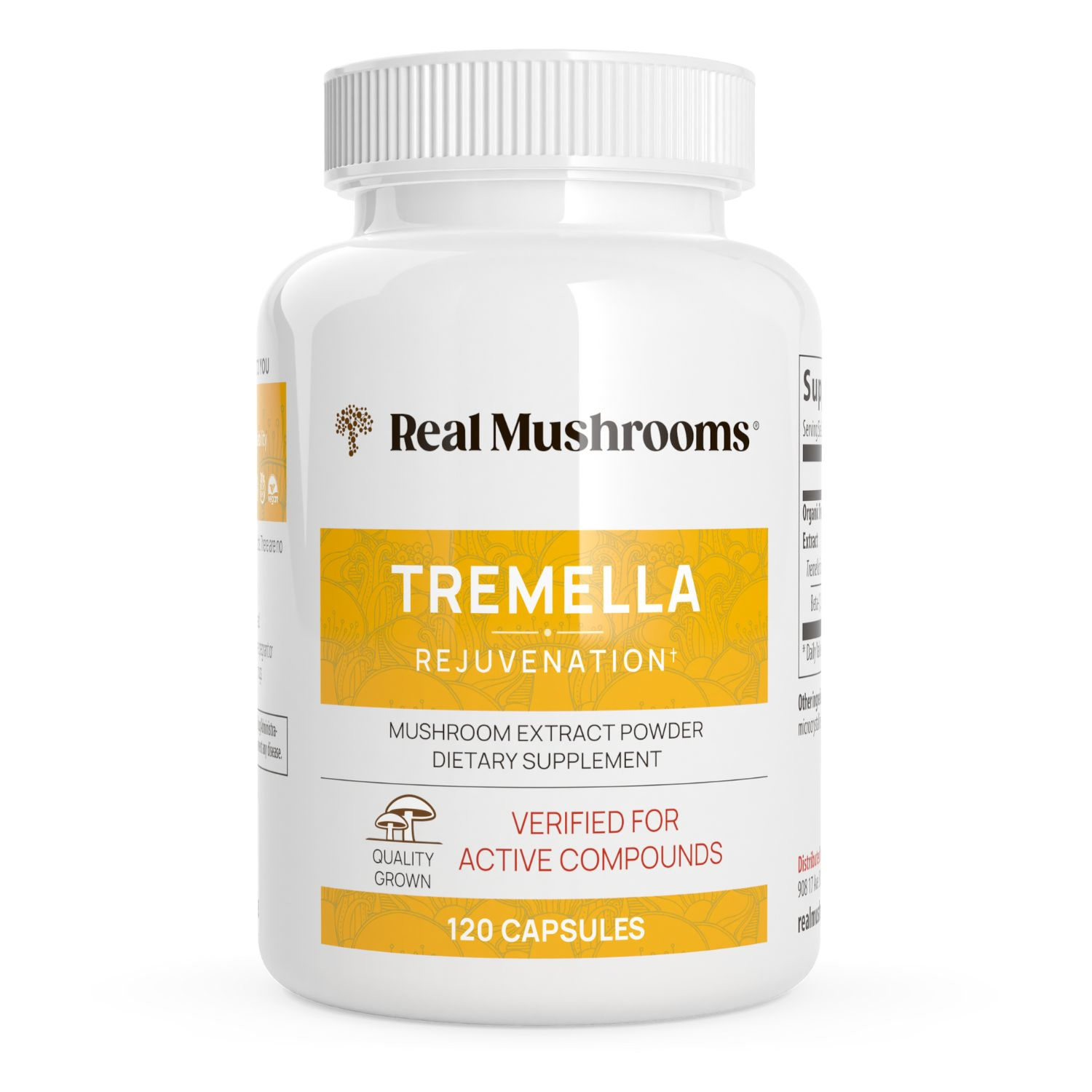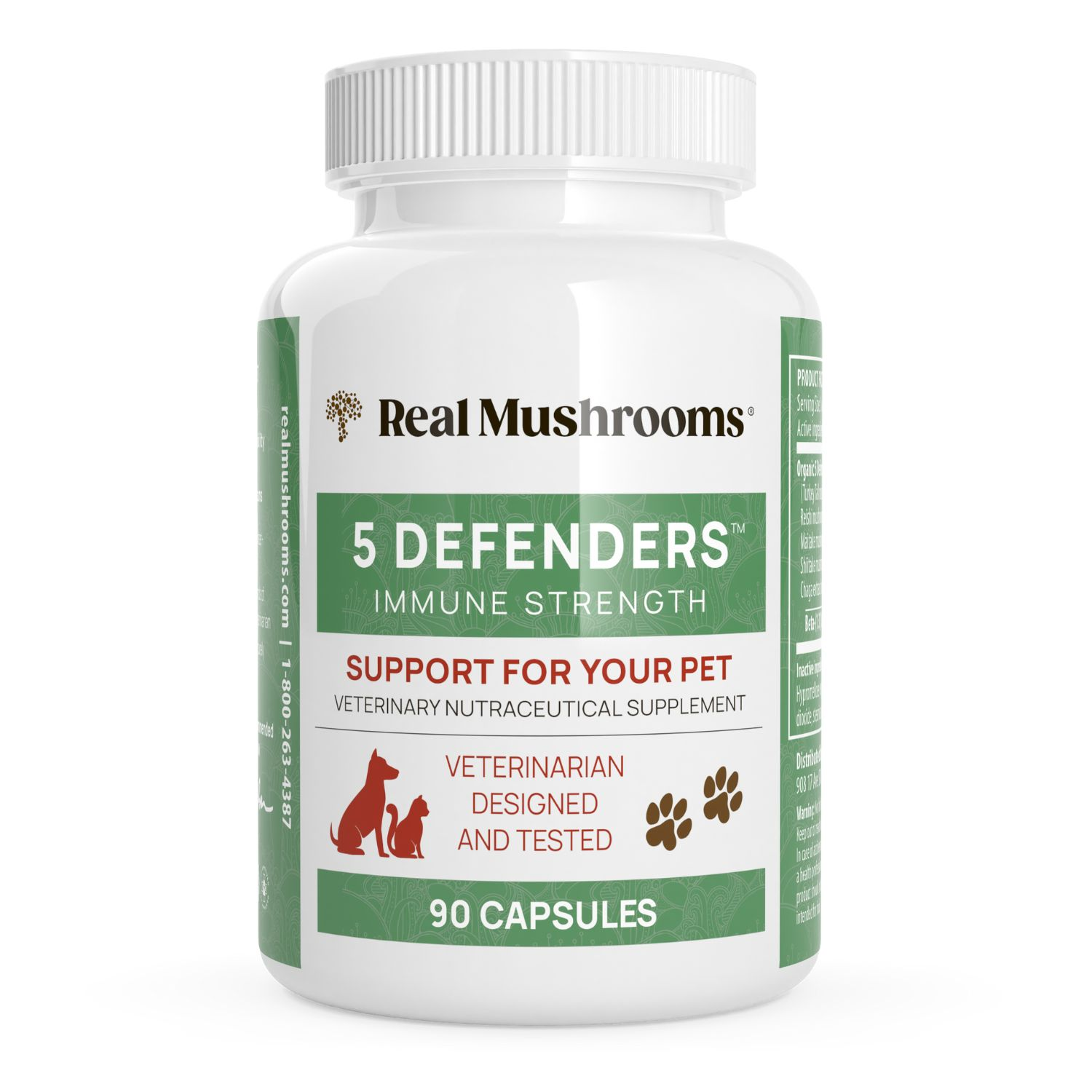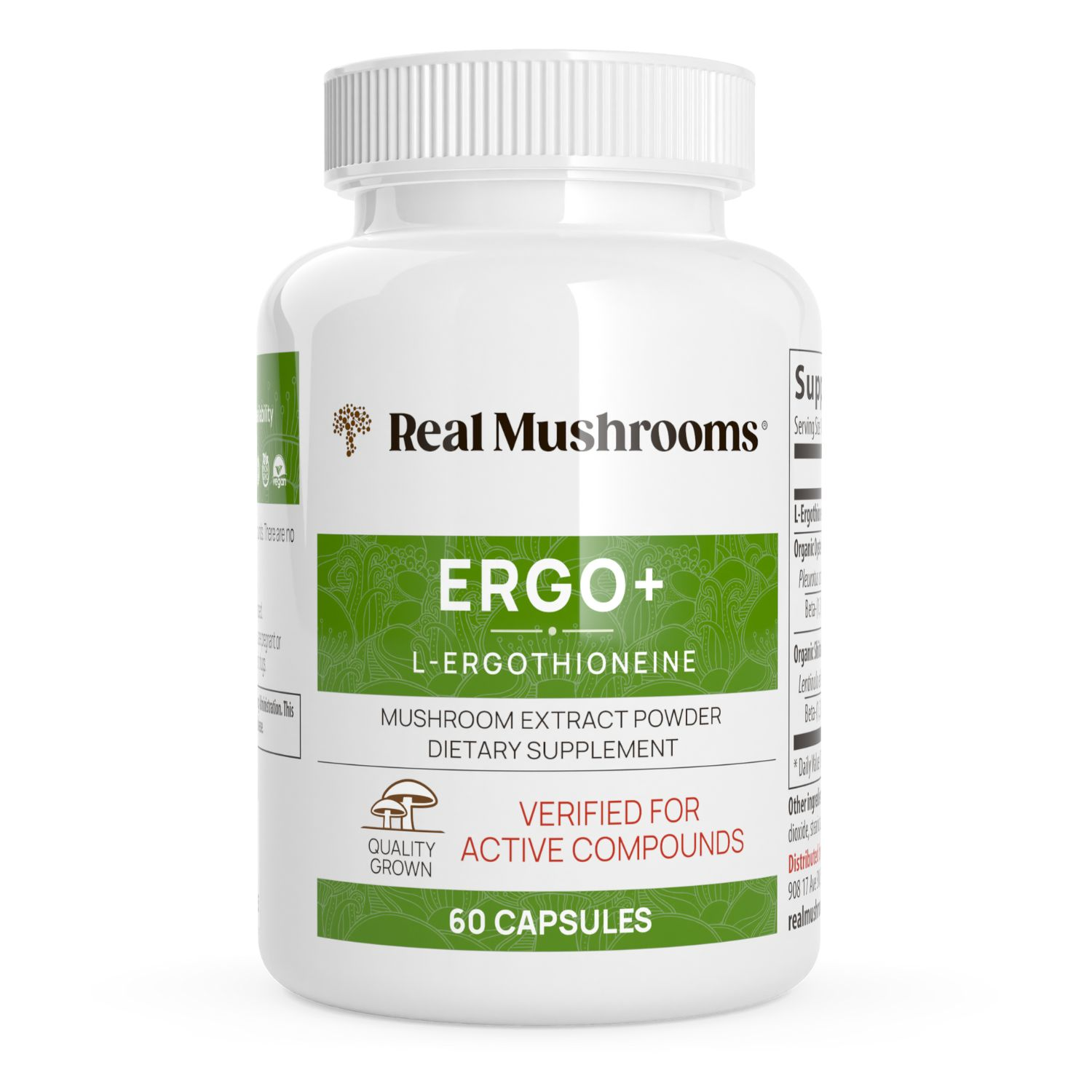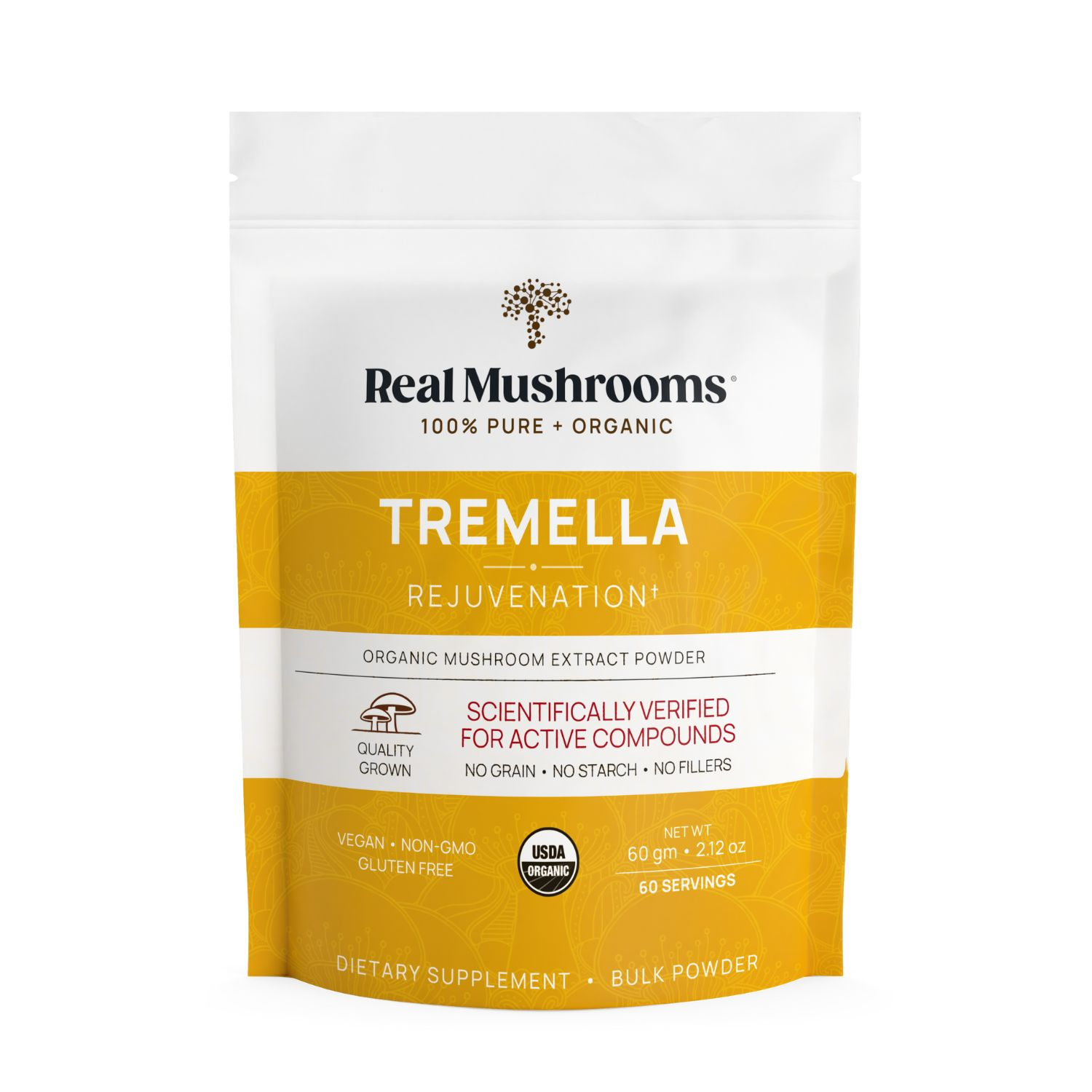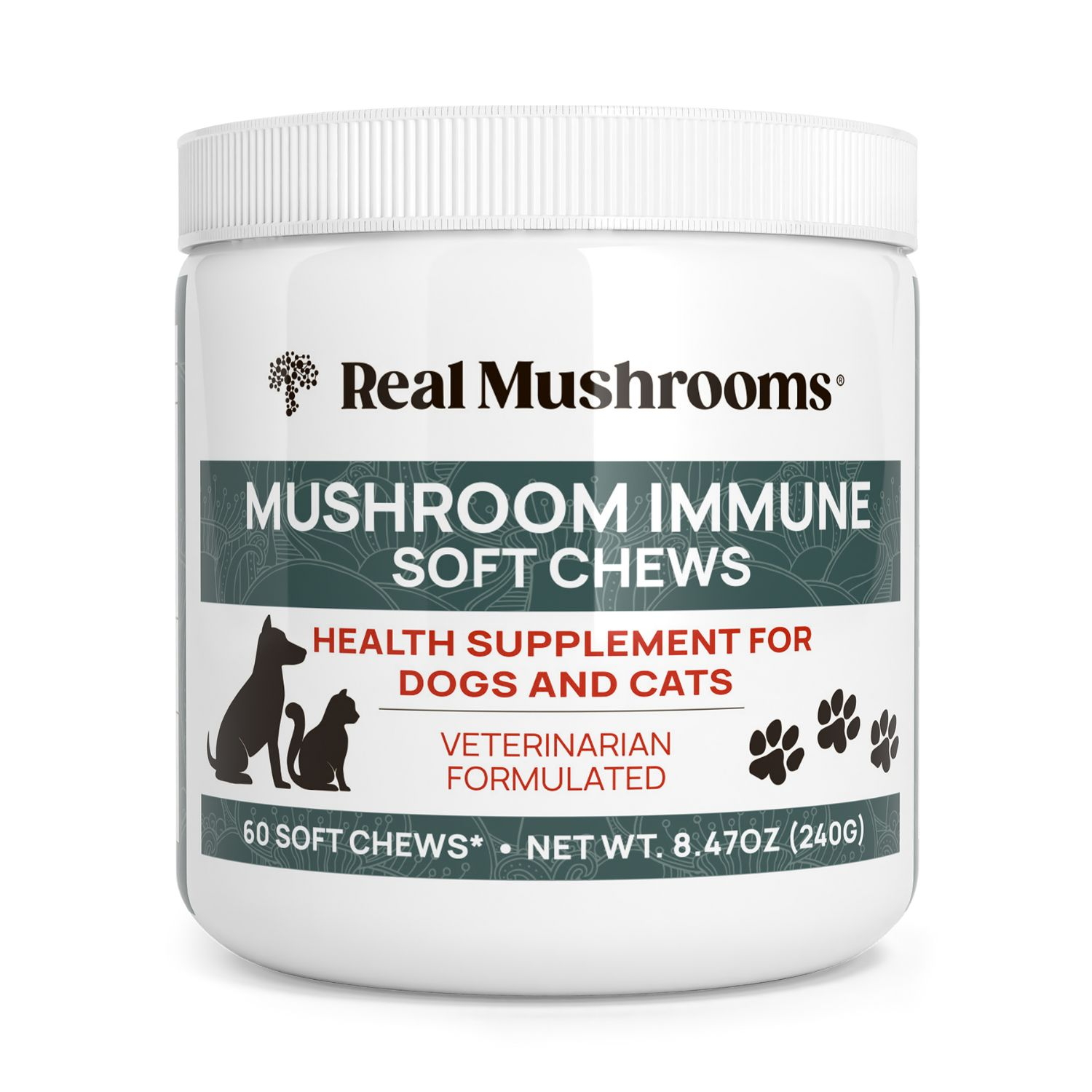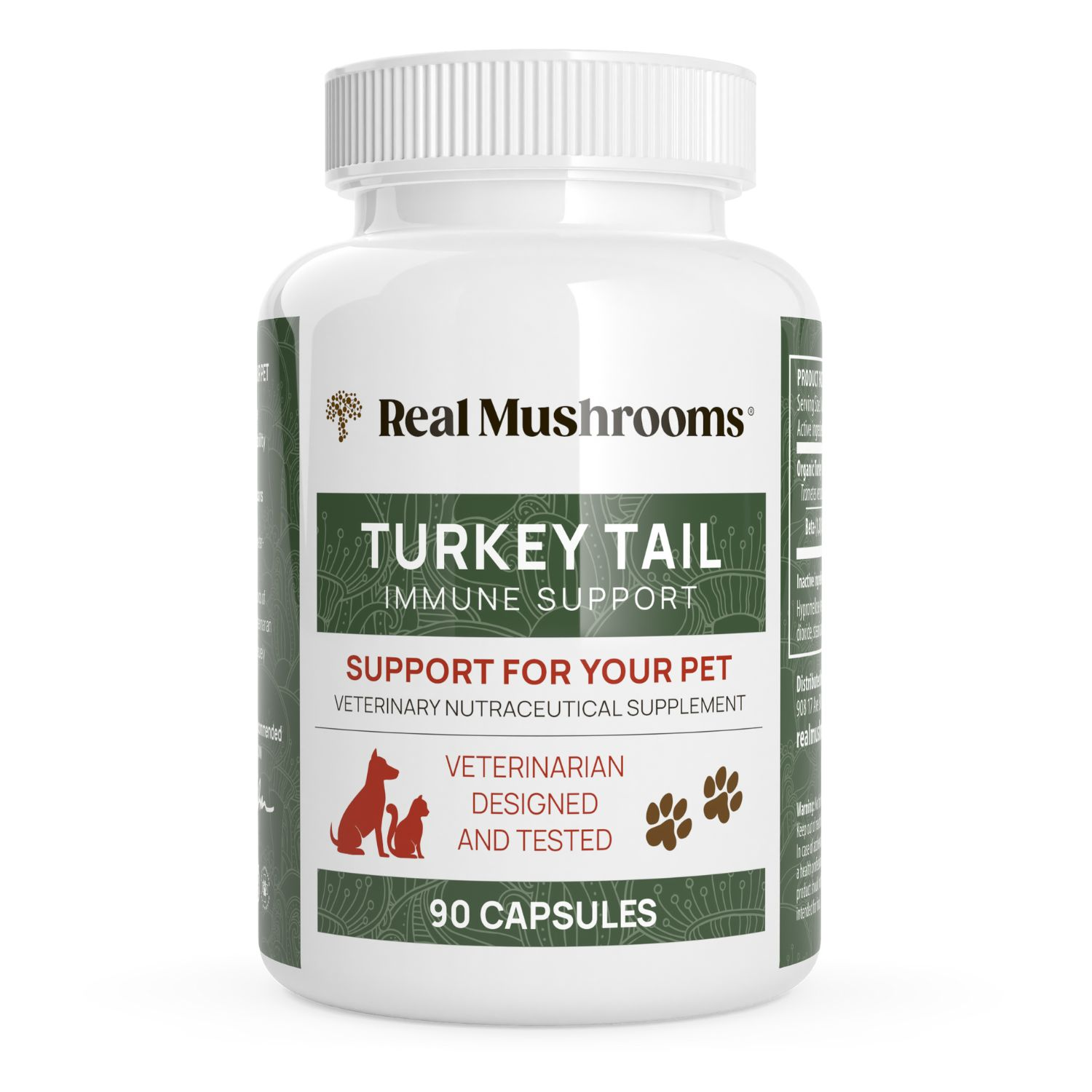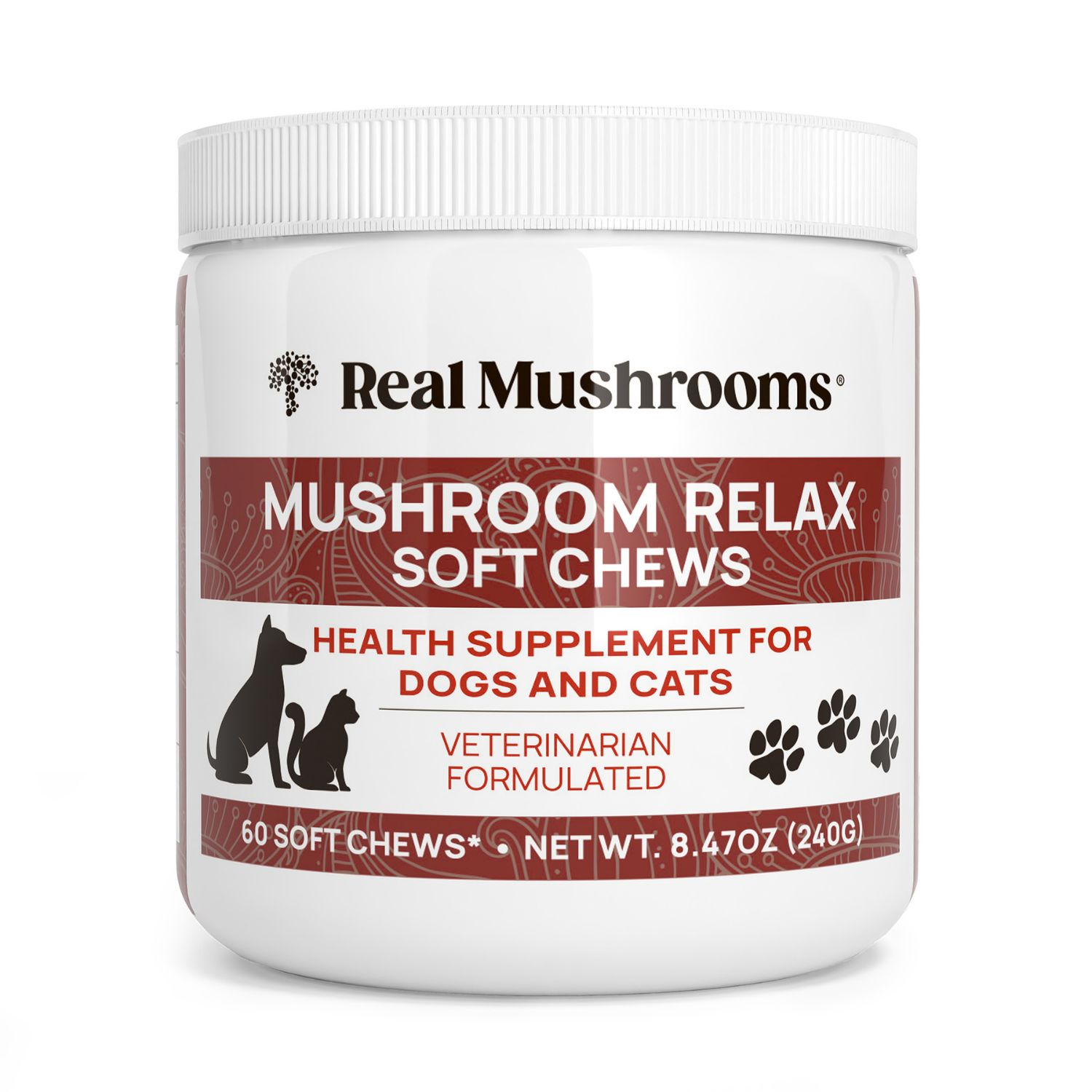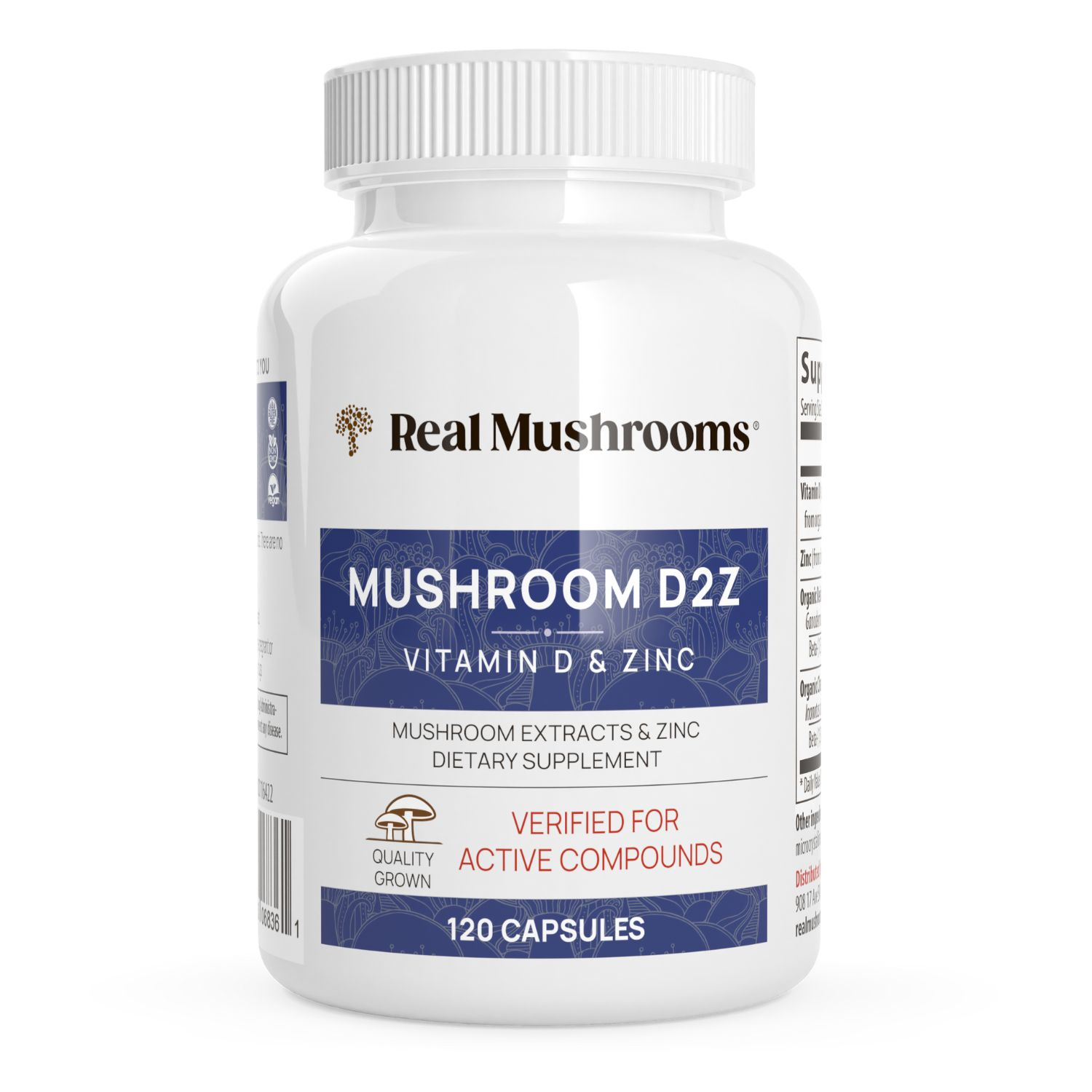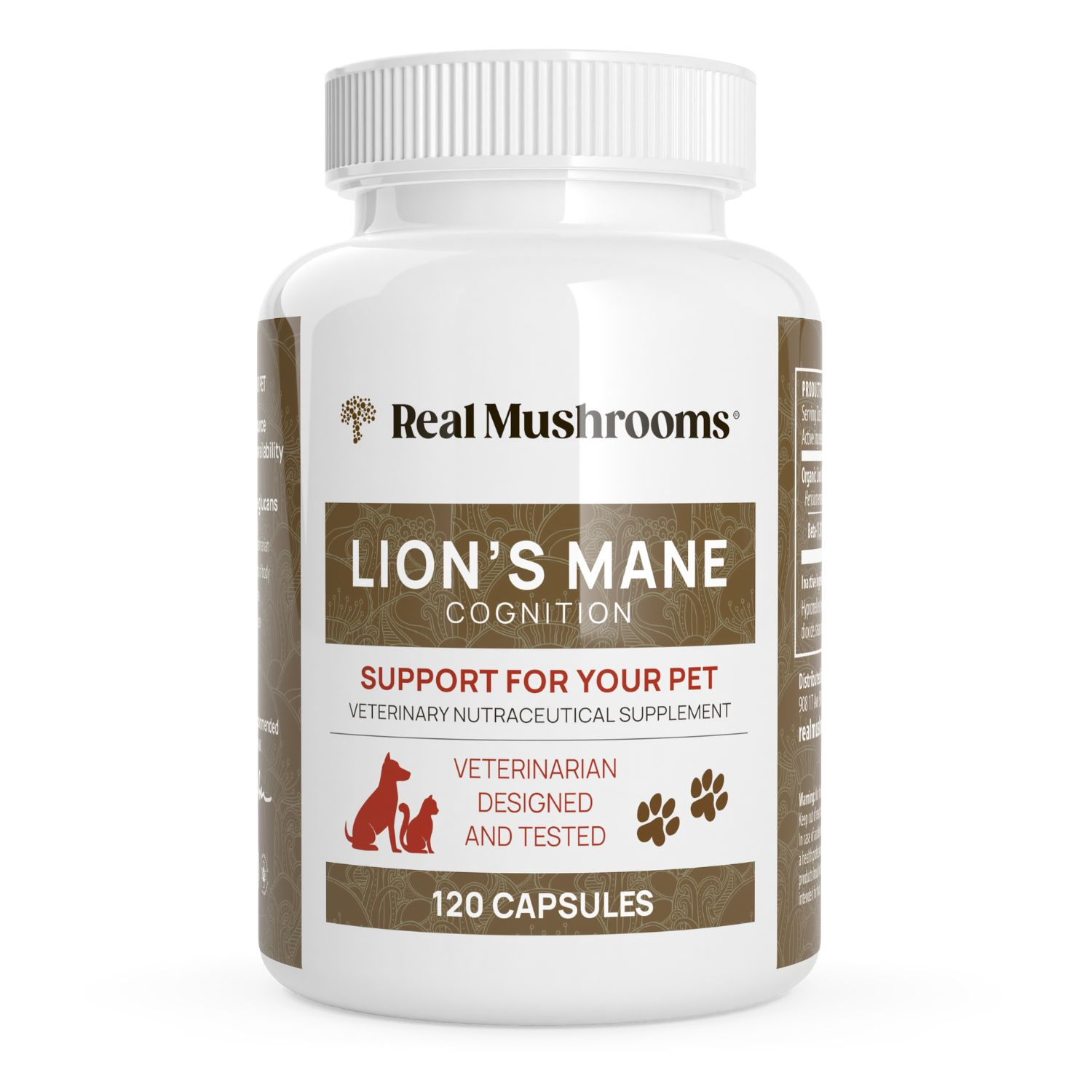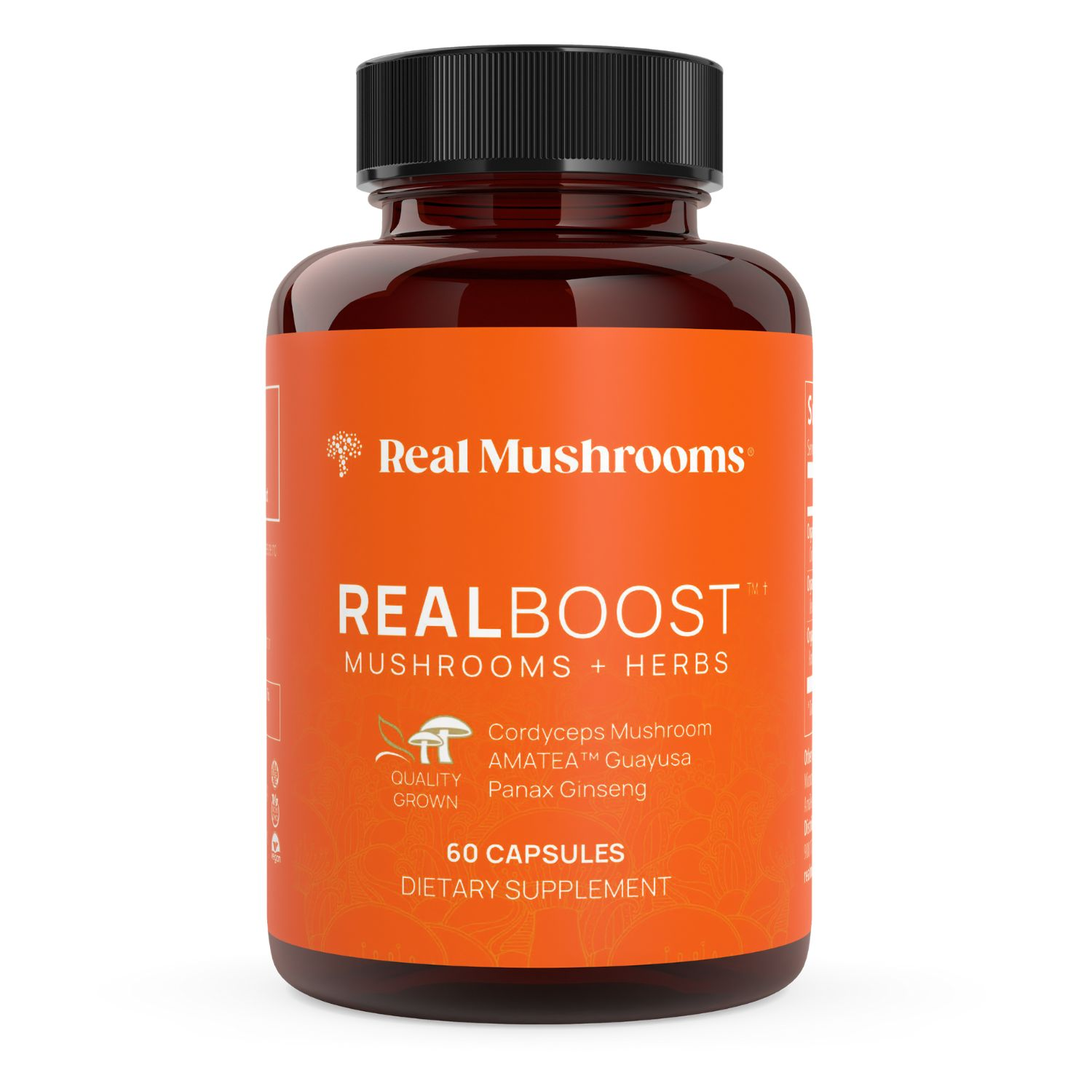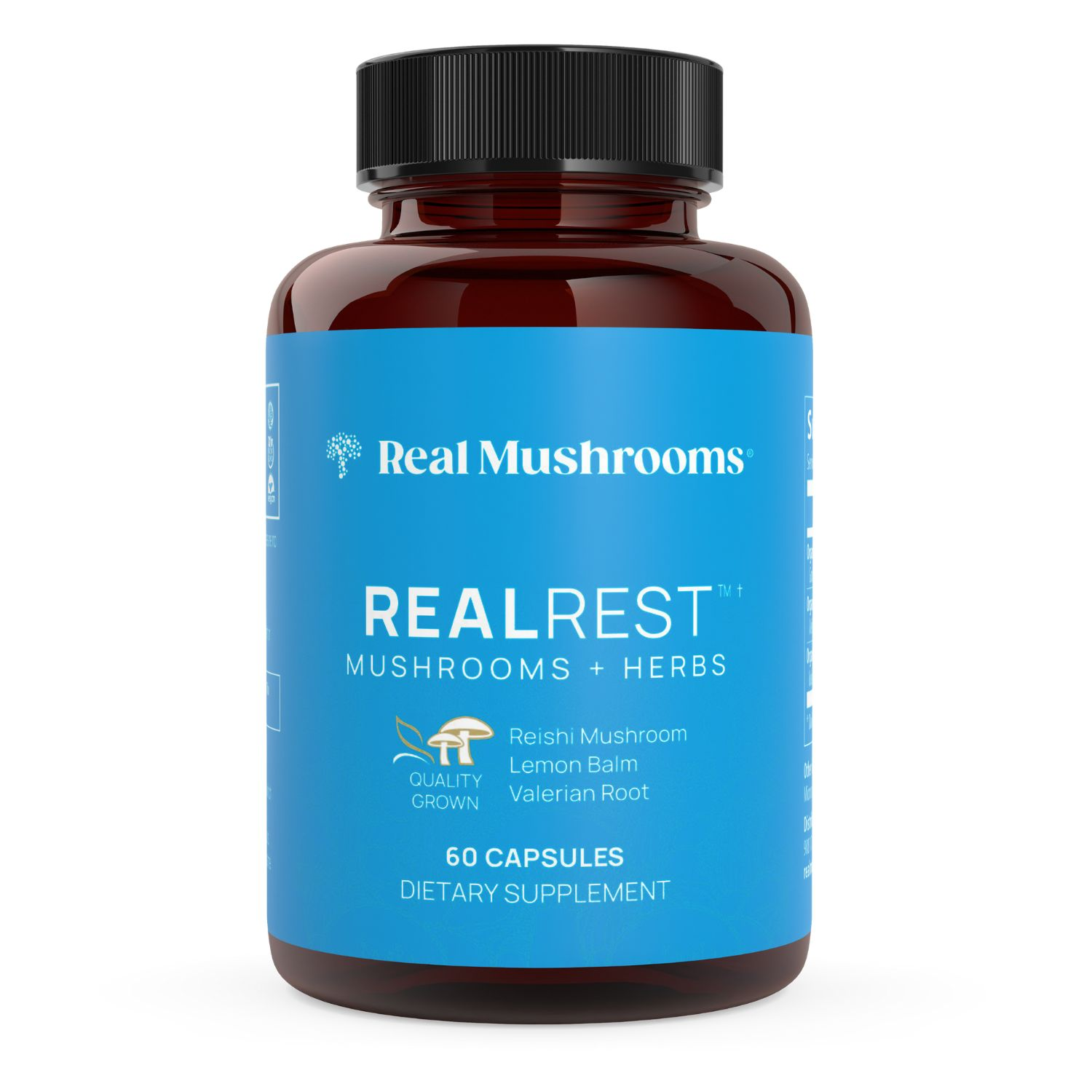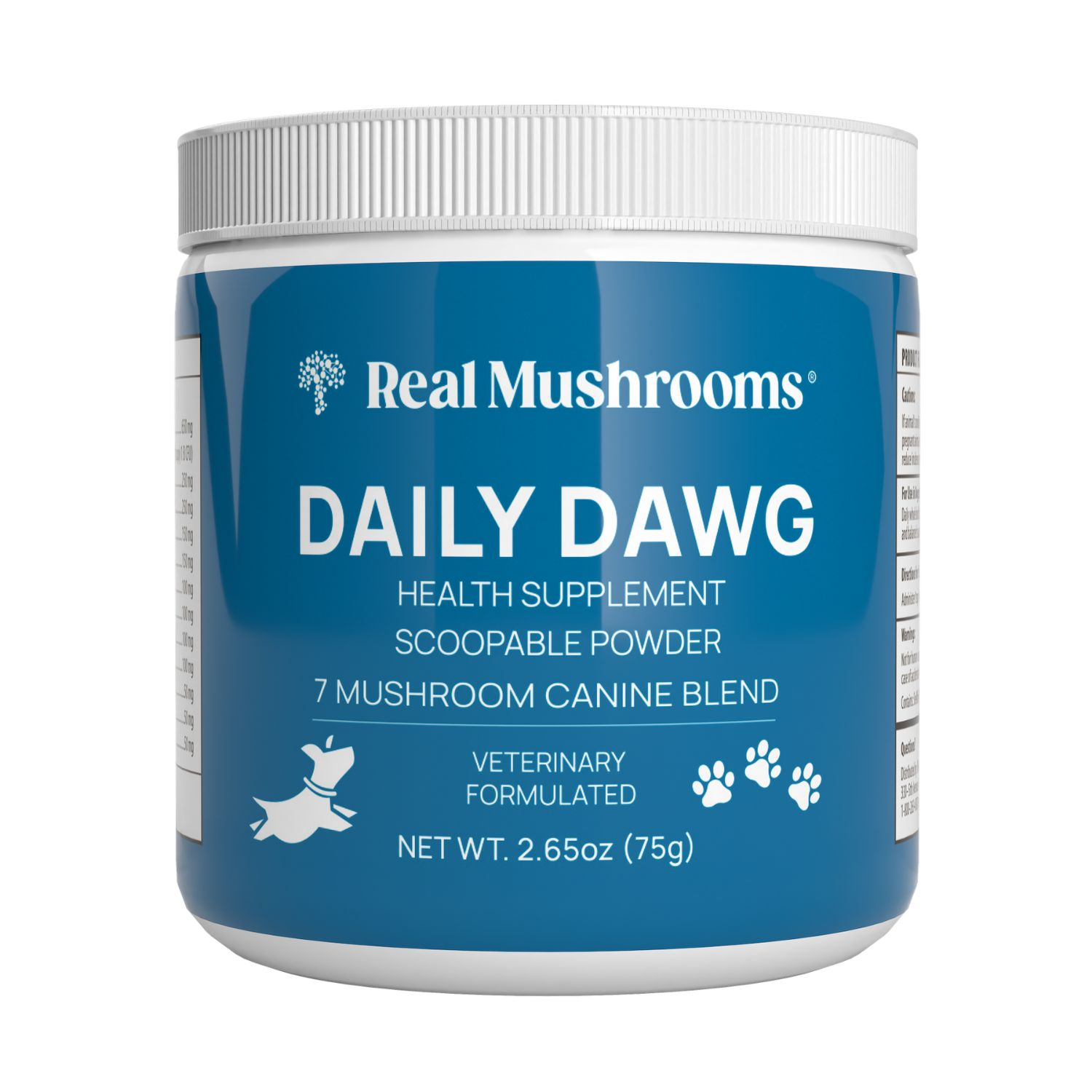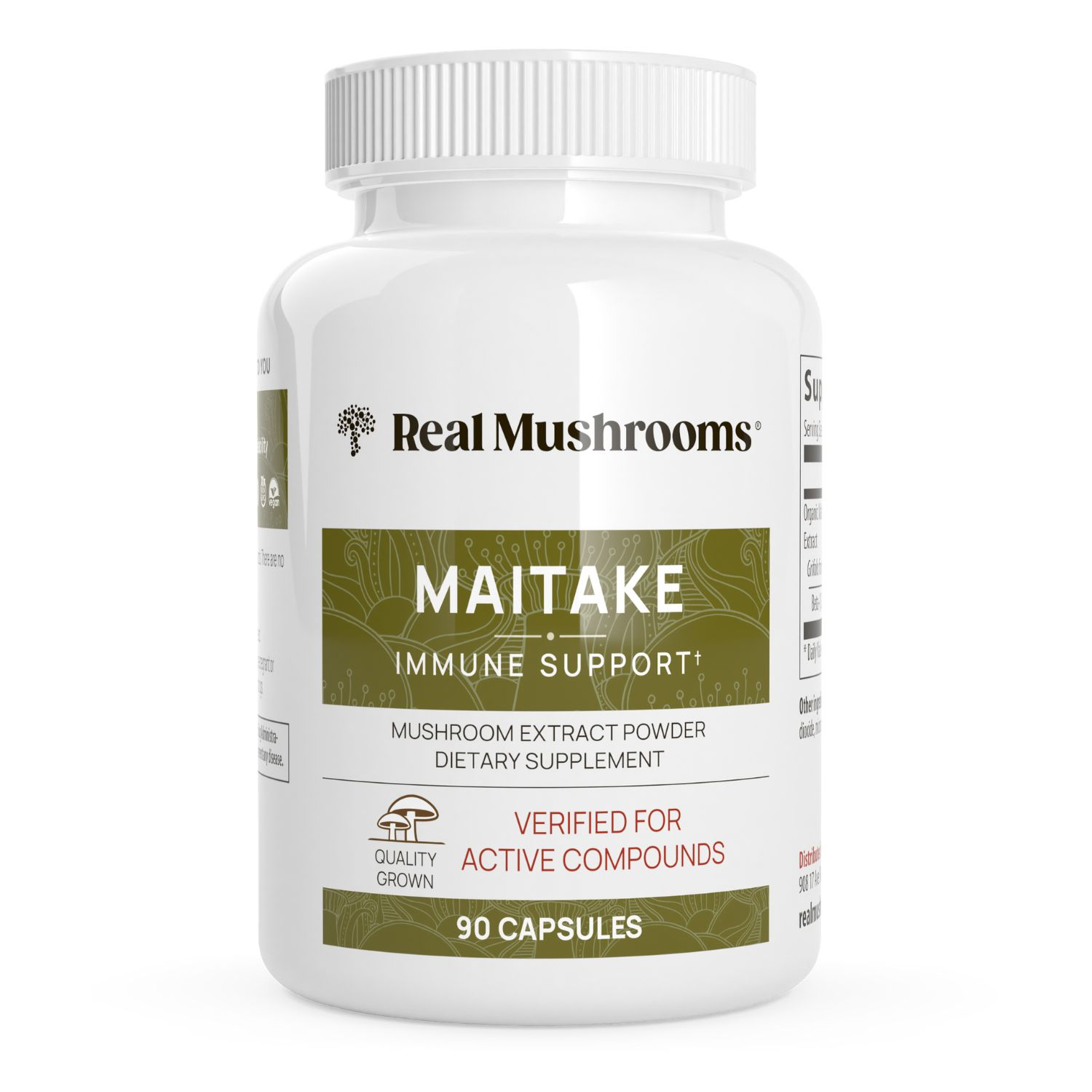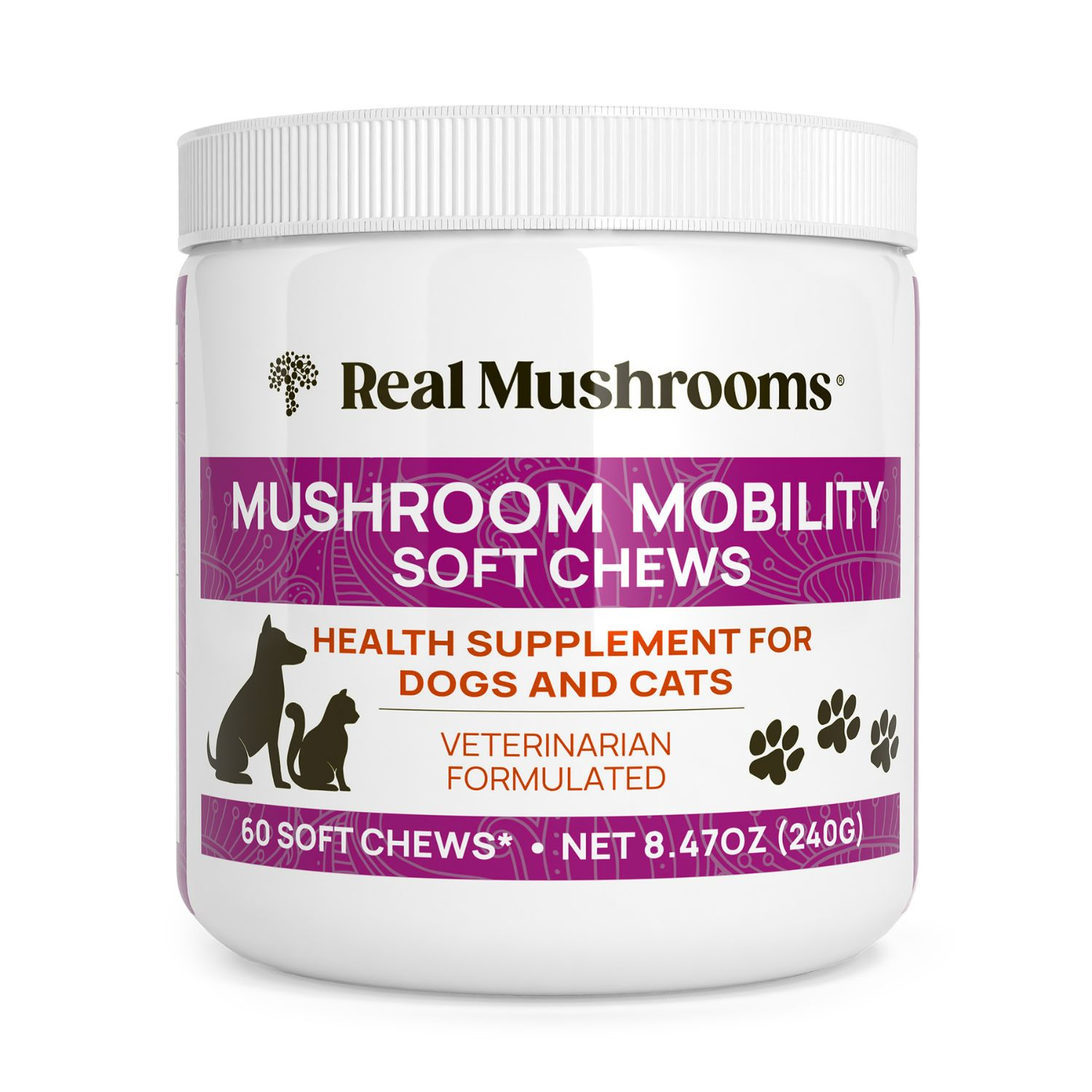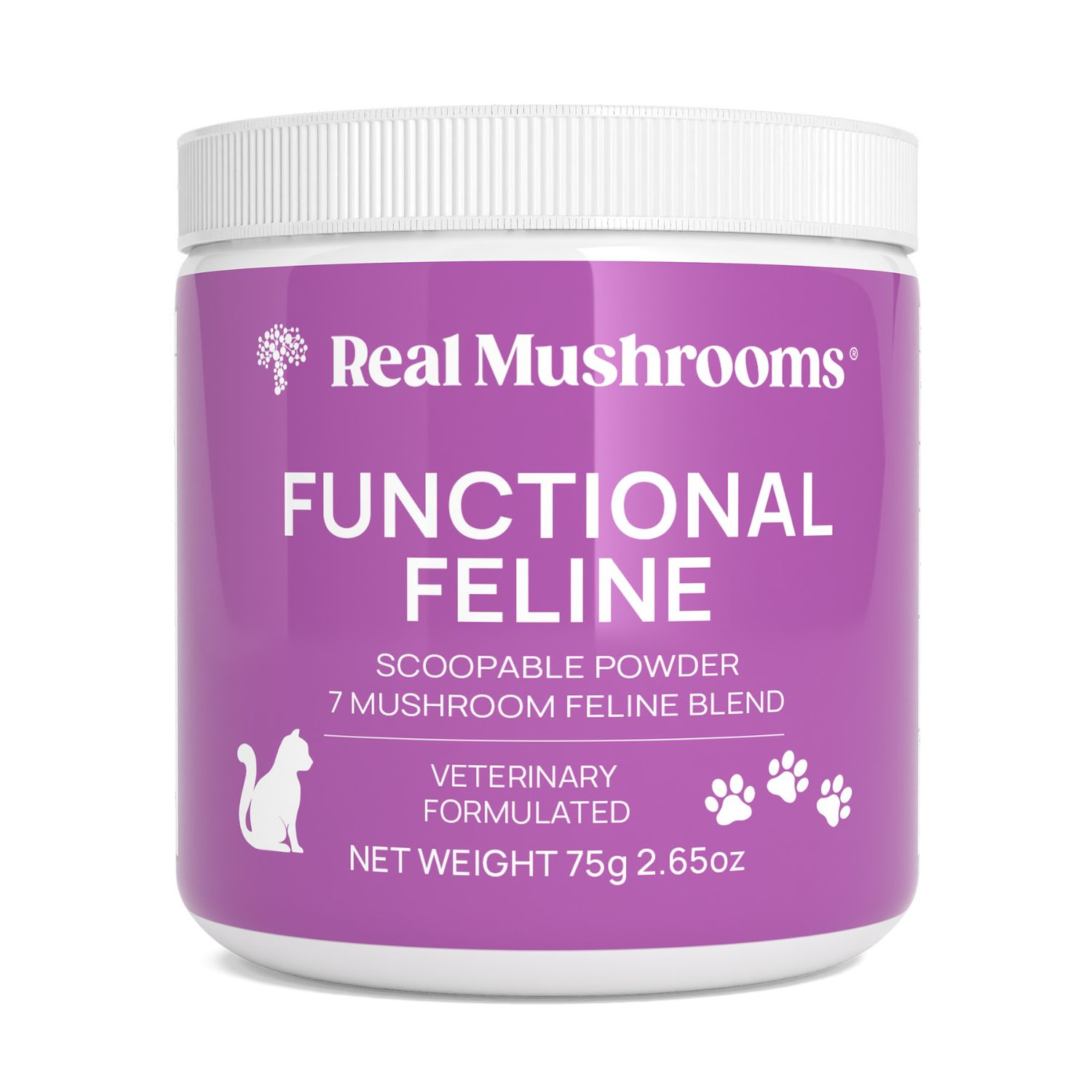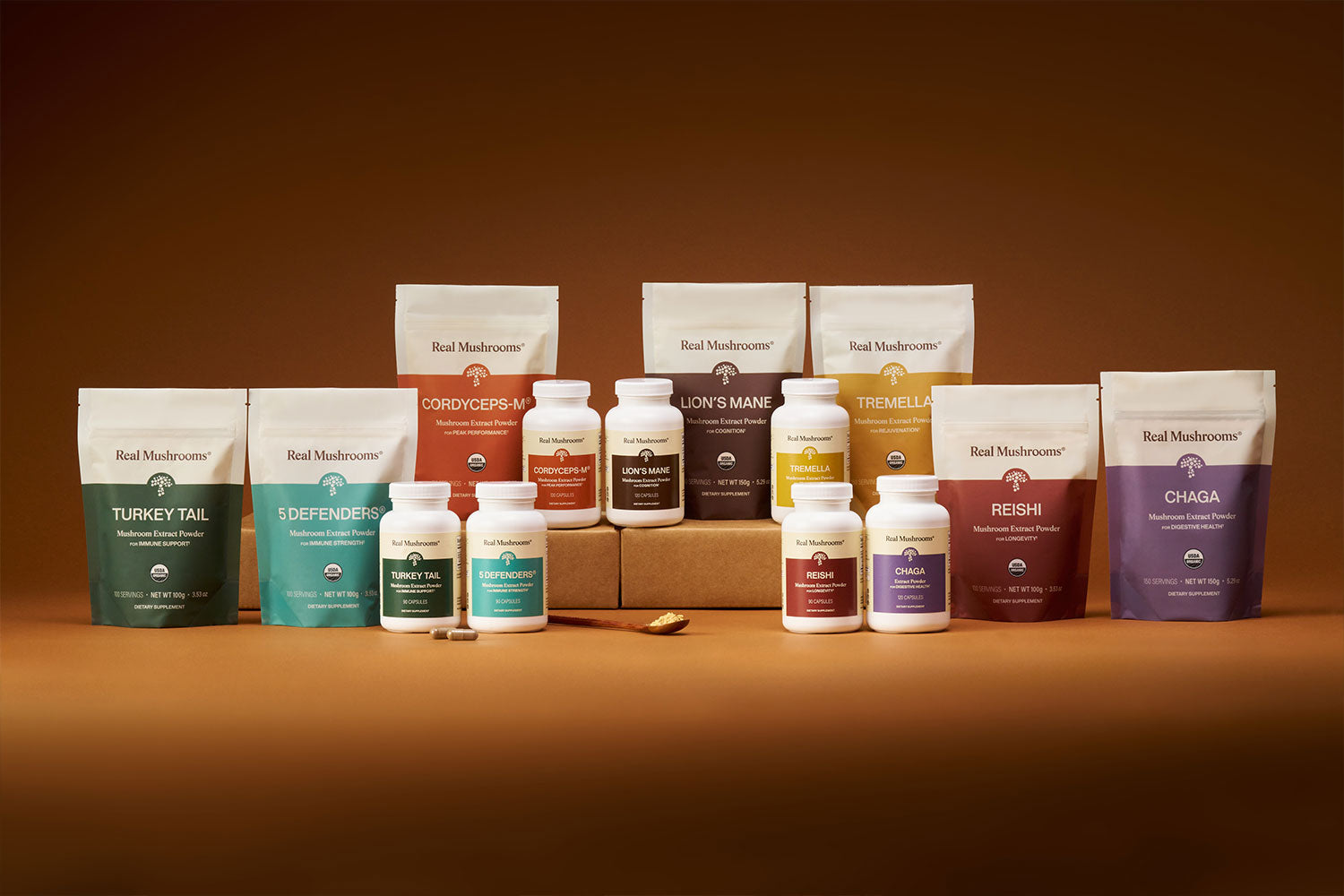Mushroom Types: A Comprehensive Guide for Health Enthusiasts
13 minute read
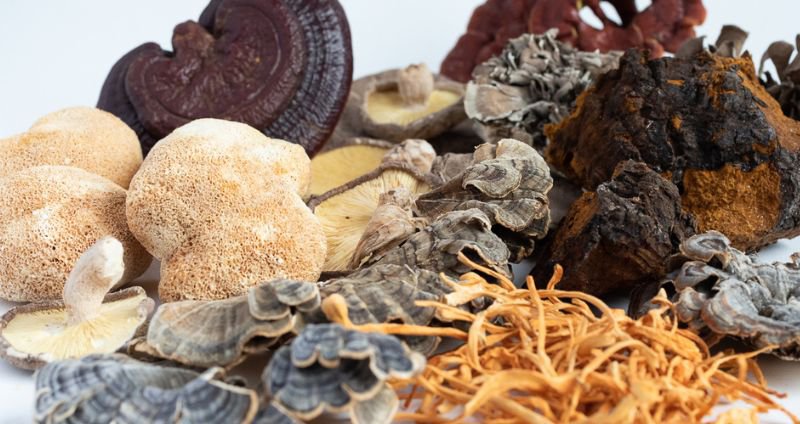
Welcome to our comprehensive guide on mushrooms. At Real Mushrooms, we’re passionate about the power of mushrooms and their potential to improve our health and well-being. We’re committed to providing trusted mushroom products of the highest quality.
Whether you’re a mushroom enthusiast or just curious about natural health supplements, we provide practical, easy-to-understand information.
Understanding the Different Types of Mushrooms
When it comes to the world of fungi, the variety is astounding. There are thousands of mushroom species, each with unique characteristics, flavors, and health benefits.
For the purpose of this guide, we’ll focus on a few key types that are particularly noteworthy for their health-boosting properties and are commonly used in natural health supplements.
Turkey Tail Mushrooms (Trametes versicolor)

Named for its colorful, fan-like appearance that resembles a turkey’s tail, this mushroom is a powerhouse of health benefits. It’s packed with antioxidants and compounds that can support your immune system.
Turkey Tail is also known for its prebiotic properties, which help to promote a healthy balance of gut flora.
Reishi Mushroom (Ganoderma lingzhi)

Often referred to as the “mushroom of immortality”, Reishi has been used in traditional medicine for centuries. It’s known for its potential to support the immune system, improve sleep quality, and reduce occasional blue moods.
Lion’s Mane Mushroom (Hericium erinaceus)

This unique mushroom, named for its shaggy, mane-like appearance, is renowned for its brain-boosting benefits. Studies suggest that Lion’s Mane can support memory, cognitive function, and nerve growth.
Chaga Mushroom (Inonotus obliquus)

While it’s a fungus that grows on trees, Chaga is not technically a mushroom. However, it is packed with antioxidants and betulinic acid that can support immune and digestive health. It’s also been linked to balancing cholesterol and blood sugar levels. It is also full of melanin that can help skin repair.
Cordyceps Mushroom (Cordyceps spp.)

This fascinating mushroom has a long history of use in Traditional Chinese Medicine. It’s known for its apparent energy-promoting and antioxidant properties. Additionally, Cordyceps is useful for supporting lung health and respiration.
Tip: When choosing a mushroom supplement, it's important to consider products made from real, organically grown mushrooms rather than mycelium grown on grain. Organically grown mushrooms can offer a broader range of beneficial compounds.
Other Common Mushroom Varieties
In addition to the well-known mushroom types, several other different kinds of mushrooms are popular in the US, each offering unique flavors and textures suitable for recipes.
Culinary mushrooms, whether fresh or dried, pack a healthful nutrient punch. However, if you want to tap into the greater health advantages of functional mushrooms, you’re best to turn to mushroom supplements for those benefits.
Button Mushrooms
Often enjoyed for their mild taste and crunchy texture when raw, button mushrooms are versatile and widely used in both vegan and non-vegan recipes. They can be stir-fried, added to noodle dishes, or used as a great meat substitute in recipes due to their meaty flavor.
Shiitake Mushroom (Lentinula edodes)
The Shiitake mushroom is a popular fungus native to East Asia, renowned for its deep, earthy flavor and numerous health benefits. It has a distinctly meaty, buttery, woody, mild flavor with smoky undertones.
Shiitake is rich in B vitamins, minerals, and bioactive compounds, studies suggest it can support immune health, promote a health inflammatory response, and may even have properties that help fight abnormal cell growth.
Additionally, Shiitake mushrooms can help improve cardiovascular health. Studies suggest that it can help to promote healthy cholesterol levels and inflammatory response.
Matsutake Mushrooms

Known for their spicy aroma and meaty flavor, matsutake mushrooms are a prized ingredient in Japanese cuisine. They are commonly sold dried and are excellent in hot pots and other dishes that allow their robust flavor to shine. Their long stems and firm texture make them ideal for a variety of recipes.
When using fresh mushrooms, always remember to pat dry them after washing to maintain their texture. It’s generally best to cook your mushrooms thoroughly to break down the tough cell walls that can make digesting them raw hard on the stomach. Cooking them also helps to unlock the compounds locked within those same cell walls.
Unique Characteristics of Each Mushroom Type
Mushrooms are incredibly diverse, each type distinguished by its own distinctive features ranging from unique flavors and textures to specific nutritional benefits and functional properties.
Let’s take a closer look at some of the most popular types of mushrooms used in natural health supplements and what makes each one special.
Turkey Tail Mushroom: Appearance, Taste, and Health Benefits
The Turkey Tail mushroom, scientifically known as Trametes versicolor, is one of the most common mushrooms found worldwide.
Appearance
Turkey Tail mushrooms are known for their striking appearance. You can identify Turkey Tail in the woods by a few traits. The top surface of the cap is velvety and displays concentric rings of colors, from creamy white and light brown to dark brown and even blue.
The underside of the cap is usually white or light-colored and contains tiny pores that release spores.
Taste and Use in Cooking
Turkey Tail mushrooms are not typically used in cooking due to their tough texture. However, they are widely used in teas and natural health supplements due to their impressive health benefits.
Turkey Tail Mushrooms Health Benefits
Turkey Tail mushrooms are packed with powerful antioxidants and compounds that support immune health. They are a motherlode of polysaccharopeptides, which have been shown to stimulate the immune system.
They are also rich in prebiotics, which help nourish the gut microbiota, promoting a healthy digestive system.

Reishi Mushrooms: Appearance, Features, and Health Benefits
The Reishi mushroom is a renowned functional mushroom with a long history of use in traditional Eastern medicine. Known for its therapeutic properties, it has been valued for centuries as a natural support for longevity.
Reishi Mushrooms: Appearance
Reishi mushrooms are easily recognizable due to their distinctive appearance. They grow out of the sides of trees or logs and have a shiny, varnished surface. Their color usually ranges from reddish-brown to black colors.
The underside of the cap lacks the typical gills of most mushrooms, instead having tiny pores through which the mushroom releases its spores. The texture of the cap is leathery, making Reishi unsuitable for traditional culinary use but ideal for teas and extracts.
Reishi Mushrooms: Taste and Use in Cooking
Reishi mushrooms are not favored for their taste, which is described as bitter and woody. This makes them unsuitable for culinary dishes typically found in kitchens.
Instead, Reishi is commonly dried, powdered, and used in teas or as an extract in various health supplements.
Reishi Mushrooms: Health Benefits
Reishi mushrooms are esteemed for their substantial health benefits. They are thought to enhance the immune system through their high content of polysaccharides and triterpenes, which are known for their apparent antioxidant properties.
Regular consumption of Reishi contributes to improved vitality, better immune function, and increased resistance to stress and infections.
Reishi mushrooms have also been studied for their ability to balance blood pressure and cholesterol levels, to improve cardiovascular health.

Lion's Mane Mushroom
The Lion's Mane mushroom is notable for its unique, shaggy appearance that resembles a white or pale lion's mane. This mushroom is found growing on hardwood trees in temperate forests around the world.
Lion’s Mane Mushroom: Appearance
Lion's Mane mushrooms feature long, hair-like spines that hang down from a central mass, rather than the typical cap and stem structure seen in many other fungi. They can grow quite large, often reaching the size of a football.
The color typically ranges from pure white when fresh to a more yellowish tone as it ages. The flesh is tough and elastic and has a delicate musky smell when young.
Lion’s Mane Mushrooms: Taste and Use in Cooking
Lion's Mane has a mild, slightly sweet, savory taste, often compared to seafood, particularly crab or lobster. This makes it a popular choice in culinary dishes. It can be sautéed, roasted, or used in soups and sauces to add a meaty texture and a boost of umami flavor.
Lion’s Mane Mushrooms: Health Benefits
Lion's Mane is well-known for supporting cognitive and neurological health and may be a good health supplement for those with mild cognitive impairment.
Lion’s Mane contains compounds that stimulate the growth of brain cells and potentially improve the functioning of the hippocampus, a region of the brain responsible for processing memories and emotional responses.
Regular consumption can have a positive impact against occasional stress or worry while boosting mental clarity, focus, and memory.

Chaga Mushrooms
Chaga mushrooms typically grow on the bark of birch trees in cold climates. They resemble a dark, cracked chunk of charcoal rather than a typical mushroom.
Chaga Mushroom: Appearance
Chaga can be described as an irregular cracked, black-brownish, hard, brittle fungus that looks like charcoal on the outside and orangey on the inside. It has a diameter ranging from 10 to 20 cm.
Chaga Mushrooms: Taste and Use in Cooking
The Chaga mushroom is extremely tough and woody, and it is not used in traditional cooking. Instead, it is typically ground into a fine powder and used to brew tea. The flavor of Chaga tea is mild and somewhat earthy, with a slight bitterness.
Chaga Mushroom: Health Benefits
Chaga mushrooms are prized for their antioxidant properties, being rich in superoxide dismutase (SOD).
SOD is an enzyme that helps break down potentially harmful oxygen molecules in cells. It is also popular for boosting the immune system, balancing inflammation, supporting gut health, and aiding skin repair.
Additionally, Chaga mushrooms can help lower blood sugar and cholesterol levels.

Cordyceps Mushrooms
Cordyceps mushrooms, specifically Cordyceps sinensis, are known for their unusual origin: they grow on insect larvae. This fungus is highly valued in Traditional Chinese Medicine.
Cordyceps Mushroom: Appearance
The Cordyceps fungus is characterized by its unusual and somewhat startling growth process. This wild fungus emerges from the body of a dead caterpillar, which it infects and ultimately fills with its mycelia.
As it develops, the fungus produces a long, slender fruiting body that protrudes from the caterpillar host, giving it an appearance reminiscent of the insect it once inhabited.
While Cordyceps Sinensis is a rare and expensive mushroom, its relative, Cordyceps Militaris, can be cultivated at scale for supplements. Cordyceps Militaris contains even more of the key compound this mushroom is known for, called cordycepin.
Cordyceps Mushrooms: Taste and Use in Cooking
Cordyceps mushrooms are not typically used in cooking due to their rarity and health value. These mushrooms are most commonly consumed in powdered form or as an extract in supplements.
Cordyceps Mushrooms: Health Benefits
The Cordyceps mushroom is celebrated for its effects on physical stamina and energy levels. It’s thought to influence the body's production of ATP, one of the primary sources of energy during exercise.
The mushroom is also known for its benefits to lung health and respiratory functions, making it popular among athletes for improving performance and endurance. Additionally, it has properties that may support heart health and immune function.
Fun Fact: While the zombie fungus from the TV series The Last Of Us can't infect humans, its real-life counterpart Ophiocordyceps unilateralisi, a kind of Cordyceps mushroom, manipulates ants into high places to spread its spores and create more zombie ants!

Differentiating Between Edible and Non-Edible Mushrooms

When it comes to mushrooms, it’s crucial to know which ones are edible and which ones are not. There’s a wide variety of mushroom types out there, and while many are delicious and nutritious, others can be harmful or even deadly if consumed.
Many wild mushrooms should not be consumed due to their toxic nature. Some of these include:
- Death cap mushrooms: As the name suggests, these mushrooms can be deadly. They’re responsible for the majority of mushroom poisoning deaths.
- Destroying angels: These mushrooms are also highly toxic and can cause severe illness or death.
- Fly agaric: While not typically deadly, these mushrooms can cause hallucinations and other unpleasant effects.
When foraging for mushrooms, it’s essential to be 100% sure of what you’re picking. If you’re ever in doubt, it’s best to leave it alone.
When you buy mushroom powder and supplements from us at Real Mushrooms, you get all the health benefits of mushrooms without the hassle and risk of having to watch out for poisonous varieties.
To be clear, our products are made from the mushroom (fruiting body), not the mycelium. As mushroom experts, we provide ourselves with the high-quality, potent, and tested mushroom products we provide to our customers.
How to Use Mushroom Extracts

Mushroom extracts are concentrated forms of mushrooms, typically available in liquid, powder, or capsule form. They are a safer, more reliable way to consume mushrooms. You also get a much wider array of mushroom varieties from across the world.
To add mushroom extracts to your diet, start by sourcing the extracts from a trusted seller. Learn as much as you can about the seller to ensure you’re actually getting organic mushroom extracts, not mycelium grown on grain substrate.
Powdered extracts can be easily blended into meals, baked goods, or smoothies for a nutritional boost. On the other hand, capsules offer a convenient option and can be consumed with water just like any regular supplement.
This versatility ensures that you can incorporate mushroom extracts into your diet to suit your lifestyle and preferences.

Summary
We’ve explored the world of mushrooms, focusing on their types, uses, and health benefits. We’ve learned that mushrooms are not only a delicious addition to our meals but also a rich source of nutrients with potential health benefits.
These mushrooms are packed with antioxidants and compounds that can support our immune system, making them a valuable addition to a natural health supplement routine.
But, while foraging and eating fresh mushrooms may be cheaper and more tasty, it’s risky and potentially deadly if you don’t know what you’re doing.
Real Mushrooms removes the guesswork by offering expertly grown organic mushrooms (fruiting bodies). Our mushroom supplements are a dependable choice for quality and purity.
We also work hard to educate our customers about the source, processing, and painstaking standards we take for all our mushroom products. We’re firm believers in transparency about health-supporting mushrooms.
Shop our collections of 100% organic mushroom extracts, including Chaga, Cordyceps, Lion’s Mane, Reishi, Turkey Tail, and Tremella.
References
- Bioneers (2020) Solutions Underfoot: How Paul Stamets is Using Mushrooms to Save the Bees, Bioneers. Available at: https://bioneers.org/solutions-underfoot-zmaz2001/.
- Why Some Mushrooms Glow In The Dark (2015) NPR. Available at: https://www.npr.org/2015/03/21/394089178/why-some-mushrooms-glow-in-the-dark.
- UCLAhealth (2022) 7 health benefits of mushrooms, www.uclahealth.org. Available at: https://www.uclahealth.org/news/7-health-benefits-of-mushrooms.
- Rearranging the Branches on a New Tree of Life (no date) ucjeps.berkeley.edu. Available at: https://ucjeps.berkeley.edu/DeepGreen/NYTimes.html.
- Morels: Where did they start? – Oregon Mycological Society (no date) www.wildmushrooms.org. Available at: https://www.wildmushrooms.org/2021/03/19/morels-where-did-they-start/.
- Most Expensive Mushrooms Statistics: Market Data Report 2024 (no date) gitnux.org. Available at: https://gitnux.org/most-expensive-mushrooms/ (Accessed: 29 July 2024).
- Truffles (no date) National Wildlife Federation. Available at: https://www.nwf.org/Educational-Resources/Wildlife-Guide/Plants-and-Fungi/Truffles.
- Bonito, G. et al. (2013) ‘Historical Biogeography and Diversification of Truffles in the Tuberaceae and Their Newly Identified Southern Hemisphere Sister Lineage’, PLOS ONE, 8(1), pp. e52765–e52765. Available at: https://doi.org/10.1371/journal.pone.0052765.
- Aghajani, H. et al. (no date) ‘Influence of relative humidity and temperature on cultivation of Pleurotus species’, Maderas. Ciencia y tecnología, 20(4), pp. 571–578. Available at: https://www.redalyc.org/journal/485/48557888005/html/.
- Reishi – MycoMedicine (no date) mycomedicine.org. Available at: https://mycomedicine.org/medicinal-mushrooms/reishi-mushroom/ (Accessed: 29 July 2024).
- 5 Lion’s Mane Mushroom Benefits (no date) Cleveland Clinic. Available at: https://health.clevelandclinic.org/lions-mane-mushrooms-benefits.
- Five Fun Mushroom Facts for Kids & Educators – Mushrooms in Schools (2021) The Mushroom Council. Available at: https://www.mushroomcouncil.org/schools/mushroom-facts-for-kids/.
- Docherty, S., Doughty, F.L. and Smith, E.F. (2023) ‘The Acute and Chronic Effects of Lion’s Mane Mushroom Supplementation on Cognitive Function, Stress and Mood in Young Adults: A Double-Blind, Parallel Groups, Pilot Study’, Nutrients, 15(22), pp. 4842–4842. Available at: https://doi.org/10.3390/nu15224842.
- The Real Mushrooms Story: How it all started (no date) Real Mushrooms. Available at: https://www.realmushrooms.com/who-we-are/.
- Which Mushrooms to Avoid: The Inglorious Seven - Penny Post (2018). Available at: https://pennypost.org.uk/2018/08/poisonous-mushrooms/ (Accessed: 29 July 2024).
- Trust, W. (2022) Poisonous mushrooms in the UK, Woodland Trust. Available at: https://www.woodlandtrust.org.uk/blog/2022/10/poisonous-mushrooms/.
- Ragucci, S. et al. (2023) ‘Isolation, Characterization, and Biocompatibility of Bisporitin, a Ribotoxin-like Protein from White Button Mushroom (Agaricus bisporus)’, Biomolecules, 13(2), p. 237. Available at: https://doi.org/10.3390/biom13020237.
- Harvard T.H. Chan (2020) Mushrooms, The Nutrition Source. Available at: https://www.hsph.harvard.edu/nutritionsource/food-features/mushrooms/.
- Lo, H.-C. et al. (2013) ‘A Systematic Review of the Mysterious Caterpillar Fungus Ophiocordyceps sinensis in Dong-ChongXiaCao (冬蟲夏草 Dōng Chóng Xià Cǎo) and Related Bioactive Ingredients’, Journal of Traditional and Complementary Medicine, 3(1), pp. 16–32. Available at: https://doi.org/10.4103/2225-4110.106538.
- Tuli, H.S., Sandhu, S.S. and Sharma, A.K. (2013) ‘Pharmacological and therapeutic potential of Cordyceps with special reference to Cordycepin’, 3 Biotech, 4(1), pp. 1–12. Available at: https://doi.org/10.1007/s13205-013-0121-9.
- Lu, Y. et al. (2021) ‘Recent Developments in Inonotus obliquus (Chaga mushroom) Polysaccharides: Isolation, Structural Characteristics, Biological Activities and Application’, Polymers, 13(9), p. 1441. Available at: https://doi.org/10.3390/polym13091441.
- 4 Benefits of Chaga Mushrooms (no date) Cleveland Clinic. Available at: https://health.clevelandclinic.org/chaga-mushroom-benefits.
- Géry, A. et al. (2018) ‘Chaga (Inonotus obliquus), a Future Potential Medicinal Fungus in Oncology? A Chemical Study and a Comparison of the Cytotoxicity Against Human Lung Adenocarcinoma Cells (A549) and Human Bronchial Epithelial Cells (BEAS-2B)’, Integrative Cancer Therapies, 17(3), pp. 832–843. Available at: https://doi.org/10.1177/1534735418757912.
- Fordjour, E. et al. (2023) ‘Chaga mushroom: a super-fungus with countless facets and untapped potential’, Frontiers in Pharmacology, 14, p. 1273786. Available at: https://doi.org/10.3389/fphar.2023.1273786.
- 5 Lion’s Mane Mushroom Benefits (no date) Cleveland Clinic. Available at: https://health.clevelandclinic.org/lions-mane-mushrooms-benefits.
- Lion’s Mane & Your Brain | Cognitive Vitality | Alzheimer’s Drug Discovery Foundation (2021) Alzdiscovery.org. Available at: https://www.alzdiscovery.org/cognitive-vitality/ratings/lions-mane.
- Trust, W. (no date) Bearded Tooth Fungus (Hericium erinaceus), Woodland Trust. Available at: https://www.woodlandtrust.org.uk/trees-woods-and-wildlife/fungi-and-lichens/bearded-tooth/.
- Cör Andrejč, D., Knez, Ž. and Knez Marevci, M. (2022) ‘Antioxidant, antibacterial, antitumor, antifungal, antiviral, anti-inflammatory, and nevro-protective activity of Ganoderma lucidum: An overview’, Frontiers in Pharmacology, 13. Available at: https://doi.org/10.3389/fphar.2022.934982.
- Reishi – MycoMedicine (no date) mycomedicine.org. Available at: https://mycomedicine.org/medicinal-mushrooms/reishi-mushroom/.
- Pallav, K. et al. (2014) ‘Effects of polysaccharopeptide fromTrametes Versicolorand amoxicillin on the gut microbiome of healthy volunteers’, Gut Microbes, 5(4), pp. 458–467. Available at: https://doi.org/10.4161/gmic.29558.
- Imtiaj, A. et al. (2007) ‘Antibacterial and Antifungal Activities ofStereum ostrea, an Inedible Wild Mushroom’, Mycobiology, 35(4), p. 210. Available at: https://doi.org/10.4489/myco.2007.35.4.210.
- Cordyceps Is a Killer Fungi With Potential Health Benefits (2023) Cleveland Clinic. Available at: https://health.clevelandclinic.org/cordyceps-benefits.
- Reishi Mushroom | Memorial Sloan Kettering Cancer Center (no date) www.mskcc.org. Available at: https://www.mskcc.org/cancer-care/integrative-medicine/herbs/reishi-mushroom.
- Heyward, G. (2023) The zombie fungus from ‘the last of us’ is real — but not nearly as deadly, NPR. Available at: https://www.npr.org/2023/01/30/1151868673/the-last-of-us-cordyceps-zombie-fungus-real.
